|
LEGA
(BALEGA,
BALEGGA, REGA, WALEGA, WAREGA)
Democratic
Republic of the Congo
The 100,000 to 250,000 Lega inhabit the virgin forest of eastern
DRC, between the great lakes and the Lualaba River, next to Luba people.
The Lega do not possess a centralized political organization, and both
men and women aspire to moral authority by gaining high rank in the
Bwami association. They live in the autonomous villages collectively
situated at the summit of a hill surrounded by a palisade. They practice
a mixed economy involving agriculture, hunting and fishing. Division of
labor is gender based and akin to the economic patterns of other tribes
living in the forest environment: men hunt and clear new land and women
cultivate manioc and other crops. The function of the
Bwami is to regulate the social, religious, and
political life of the Lega. It is conveying ethical principles and
establishing social norms. Circumcision was an indispensable process
that allowed entrance into the Bwami. It was accompanied by the
teaching of proverbs and instruction in the handling of objects endowed
with moral and practical significance. The Bwami was divided into
several levels. To pass to the next level, a series of initiations,
gifts, and payments were needed; and this meant that one had attained
certain wisdom and acquired a personal moral sense. The great ceremonies
organized for the accession to the highest level would require that
entire villages be constructed to house the clan of the candidate and
members of the other clans who often came from very far away to
participate in the festivities. The objects are frequently
moved around in various containers and grouped in large number for
ceremonial displays; for this reason, there is no large Lega art.
All Lega art is used within the context of the Bwami
society. Originally Lega art was primarily wooden, but little by little,
ivory came into use. Later many works were made of this material that
allowed more complex and refined forms and a beautiful patina. The
highest ranking members of the Bwami association commission, own,
use and interpret all Lega sculpture. The genius of the Lega artist lies
in his ability to produce a work that fulfills the requirements of the
Bwami patron, fits perfectly within the canon, and yet is
artistically unique. Various categories of objects are used in
connection with the association’s activities, including anthropomorphic
and zoomorphic figurines, masks, hats, and others. Each anthropomorphic
figurine symbolically represents a named personage with particular moral
qualities or defects that are expressed through dance and sung aphorisms
in initiations to the highest grades of the association. Although quite
primitive and coarse in style and execution, very expressive Lega
sculpture convey the strong sense of balance, form and serenity. The
Lega judge the quality of their sculpture on the basis of its
effectiveness.
|
|
Seven
idumu masks. Most of Lega masks are
sculptures of a human face that are rarely worn over the face and never
for purposes of true transformation. The Lega masks can be assigned
different uses and meanings depending on the context of the performance.
In Bwami ceremonies, masks are attached to different parts of the
body, fixed to hat, piled in stacks, hung on fences, held in the hand,
dragged on the ground, and occasionally worn on the forehead with the
beard draping over the face of the wearer or arranged on a miniature
palisade. Participants in most rites display their masks as a group in
conjunction with particular dance movements and aphorisms, which vary
depending on the context in which they are used. Lega masks differ from
those used in many other African masquerades in that while women do not
own them, both men and women handle and present them in very similar
performances. Masks are among the initiation objects displayed on the
grave before being passed to new owners. They are usually passed
from an uncle to a nephew. Idumu masks are unusual because they
belong to a group of people rather than one individual. During a major
performance an idumu mask is hung on a fence among other
smaller lukwakongo masks (these are owned by specific persons).
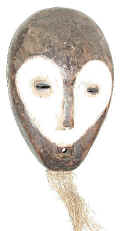
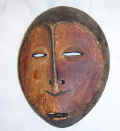
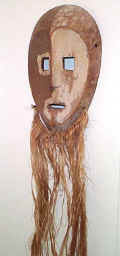
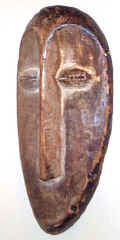
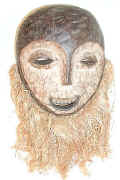
10" x 7" x 3"+ raffia
9" x 7" x 3"
10" x 7" x 2" + raffia
9" x 5" x 3"
8" x 7" x 3" + raffia |
|
|
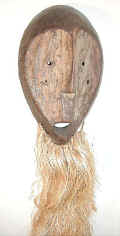
11" x 7" x 3" + raffia
|
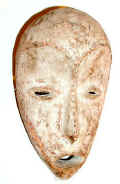
11" x 7" x 3"
|
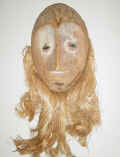
10" x 7" x 2" + raffia |
|
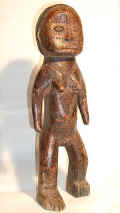 Initiation
Figure. The 100,000 Lega live in the virgin forest of Eastern part
of the country, near Lake Kivu. All Lega art is based upon the bwami
association whose hierarchy is open to both men and women. Bwami
association maintains ethical principles and establishes social norms. The
political society has a hierarchy of ranks, each one distinguished from the
others by art objects, including statuettes. The diverse, rigidly
articulated arts of the Lega are related to the initiation rites. The great
ceremonies organized for the accession to the highest level would require
that entire villages be constructed to house the clan of the candidate and
members of the other clans who often come from very far away to participate
in the festivities. The objects are frequently moved around in various
containers and grouped in large number for ceremonial display. This need for
portability is the reason why there are no large Lega artifacts. Such
statues usually belong to the elevated bwami rank. Initiation
Figure. The 100,000 Lega live in the virgin forest of Eastern part
of the country, near Lake Kivu. All Lega art is based upon the bwami
association whose hierarchy is open to both men and women. Bwami
association maintains ethical principles and establishes social norms. The
political society has a hierarchy of ranks, each one distinguished from the
others by art objects, including statuettes. The diverse, rigidly
articulated arts of the Lega are related to the initiation rites. The great
ceremonies organized for the accession to the highest level would require
that entire villages be constructed to house the clan of the candidate and
members of the other clans who often come from very far away to participate
in the festivities. The objects are frequently moved around in various
containers and grouped in large number for ceremonial display. This need for
portability is the reason why there are no large Lega artifacts. Such
statues usually belong to the elevated bwami rank.
Material: wood
Size: 17" x 6" x 4"
|
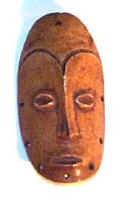
Lukingu mask. This is a small initiation object made of bone
or ivory. It not intended to be worn on the face or the body. Lukungu
is presented to the initiates as the final attainment of the Kindi
initiations. It is brought out - oiled and placed in front of its owner or
on the fence - sometimes forming a face with several other initiation
objects.
Material: bone
Size: 4" x 3" x 1" bone
|
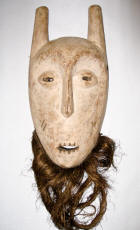
Kayamba mask. These masks with horns, known as
Kayamba masks are used only in a few regions - thus they are rare masks.
They usually belong to accomplished teachers. they are used by men and women
in ceremonies with singing, drama, etc.
Material: wood, rafia
Size: 4" x 7" x 4" + raffia |
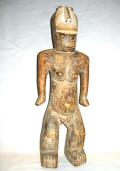
Human Figure. Among the Bwami it was common to order a human
figure from an artist. The client would specify the material to be used, and
the pose - or the elements of the sculpture. Thus the artist would know
whether to carve a male or a female figure using wood or bone with its head
raised, arms by its sides, etc. The use of the figure was not necessarily
revealed to the artist. During the dedication ceremony, the piece acquired
its meaning and designation - known to its owners. Once the figure was sold
- its meaning bacame unknown - as with this piece.
Materia: wood, pigment
Size: |
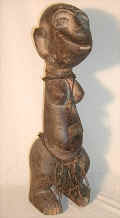
attributed to Kaguru.
Materials: wood, rope
Size: 26" x 8" x 8" |
|
LELE
(BASHILELE,
BASHILYEEL, BASTILELE, LEELE, SHILELE)
Democratic Republic of the Congo
The 20,000 to 30,000 Lele people occupy
the western region of the Kuba kingdom. The men work in the forest,
where they hunt in groups, locate medicinal plants, cut wood, sculpt,
and communicate with the spirits. The women are in charge of the food
crops and of fishing in the marshes; feeding the village is their
responsibility. The sculptor hunts, extracts palm wine, and participates
in daily assemblies. Heading the Lele is the nymi, a king with
limited powers. The village is organized according to age groups, with
the oldest man as chief. The elders have a monopoly over the traditional
cults, created to ensure the fertility and prosperity of the village.
Presently, the elders are still the depositories of healers, who used to
be organized into the banging society and subject to initiation.
This society included mature men as well as the parents of twins, who
were considered to be mediators between the spirits and humans.
The art of the Lele is not well known. It is
similar to Kuba styles with the exception of its masks, which generally
have a flattened shape. The most important forms of Lele art are carved
drums, divination instruments, boxes, pipes, and palm wine cups.
Also Lele carvers produce statuettes and face masks. The masks often
have slit eyes. The functions of the masks are little known.
Lele masks appeared in dances accompanying the burial rites of chiefs
and in annual foundation/creation ceremonies. Although the art
of the Lele borrows many elements from the Kuba and Dengese in
particular, the hairdo and long braids of the statuettes distinguish
them from any others. The Lele also use different prestige objects. The
figures on these objects occasionally have a coiffure with two long
plaits down the back. |
|
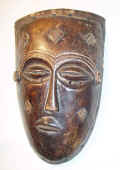
Ceremonial mask. The 20,000 to 30,000
Lele people occupy the western region of the Kuba kingdom. Heading the Lele
is a king with limited powers. The village is organized according to age
groups, with the oldest man as chief. The elders have a monopoly over the
traditional cults, created to ensure the fertility and prosperity of the
village and success for hunters. The men work in forest, where they hunt,
locate medicinal plants, cut wood, sculpt, and communicate with the spirits.
The women are in charge of the food crops and of fishing in the marshes;
feeding the village is their responsibility. In their language, and artistic
traditions they are related to the Kuba people. The sculptor hunts, extracts
palm wine, and participates in daily assemblies. The Art of the Lele is not
well known. It is similar to Kuba styles with the exception of its masks,
which generally have a flattened shape.
Each artist has a lean-to in the part of
the village belonging to his age group. Lele masks are thought to have
appeared in dances accompanying the burial rites of chiefs and in annual
foundation/creation ceremonies.
Material: wood
Size: 13" x 8" x 4" |
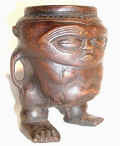 Palm-wine
cup (nteka).
The 20,000 to 30,000 Lele
people occupy the western region of the Kuba kingdom. The men hunt in
groups, locate medicinal plants, cut wood, sculpt, and communicate with the
spirits. The women are in charge of the food crops and of fishing in the
marshes; feeding the village is their responsibility.
The art of the Lele is not well known. In some
respects, it is similar to Kuba. The most important forms of Lele art are
carved drums, divination instruments, boxes, pipes, and palm wine cups.
In earlier days, cups belonged to
one age group and would pass from member to member, thus creating a bond
between participants. In the more secret ceremonies, the cup had a ritual
role and could only be seen by initiates. Always anthropomorphic, made of
rot-proof wood, it is resistant to insects. Palm-wine
cup (nteka).
The 20,000 to 30,000 Lele
people occupy the western region of the Kuba kingdom. The men hunt in
groups, locate medicinal plants, cut wood, sculpt, and communicate with the
spirits. The women are in charge of the food crops and of fishing in the
marshes; feeding the village is their responsibility.
The art of the Lele is not well known. In some
respects, it is similar to Kuba. The most important forms of Lele art are
carved drums, divination instruments, boxes, pipes, and palm wine cups.
In earlier days, cups belonged to
one age group and would pass from member to member, thus creating a bond
between participants. In the more secret ceremonies, the cup had a ritual
role and could only be seen by initiates. Always anthropomorphic, made of
rot-proof wood, it is resistant to insects.
Material: wood
Size:
6" x 6" x 4" |
|
LIGBI |
|
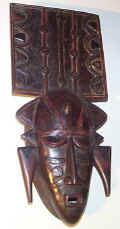
Do
ceremonial mask. Among
non-Moslem groups in extensive areas of northern Côte d'Ivoire are known for
an institution called Do or Lo, one of whose most striking
public manifestations is colorful masquerade dancing. The performance of the
maskers is accompanied by singing and dancing, expresses the joy. The Do
masks, in style and design, recalls the kpelie masks of the Senufo,
from which they are derived. Its regular features reflect the Ligbis’ ideal
of feminine beauty. These masks are danced during the funerals of
distinguished Moslem holy men, and their performances also mark critical
moments during the Muslim calendar year, and at the end of Ramadan, the
moth-long Islamic fast. The masqueraders are greatly admired for the grace
of their dance movements, which they perform in pairs and in perfect unison.
Material: wood
Size: 17" x 7" x 3" |
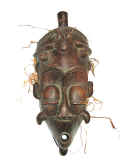
Do ceremonial mask.
The Islamized communities
who live as traders and artisans among non-Moslem groups in extensive areas
of northern Côte d'Ivoire are known for an institution called Do or
Lo, one of whose most striking public manifestations is colorful
masquerade dancing. The performance of the maskers is accompanied by singing
and dancing, expresses the joy. The classical Do mask, in style and
design, recalls the kpeliyee masks of the Senufo, from which they are
derived. These masks are among the most popular of those used by the Do
society. They are danced during the funerals of distinguished Moslem holy
men, and their performances also mark the end of Ramadan. The masqueraders
are greatly admired for the grace of their dance movements, which they
perform in pairs and in perfect unison.
Material: wood
Size:
16" x 8" x 6" |
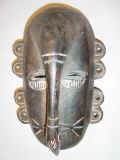
Yangaleya hornbil
mask. The yangaleya mask is
generally in the form of a humanoid face with a long beak-like protrusion
extending downwards from the forehead. In this mask human features are
combined with the powerful bill of the hornbill bird.
The masks of this type are also valued for
the positive qualities ascribed to the hornbill, whose behavior and family
life are considered exemplary by the Ligbi. They attach great importance to
this bird, considering it one of mythical primeval animals, an attendant on
the souls of the dead and a symbol of fertility. The Ligbi masqueraders are
greatly admired for the grace of their dance movements, which they perform
in pairs and in perfect unison.
Material: wood
Size:
11" x 7" x 6"
|
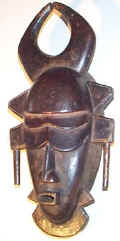
Mask of the Do
society. The Do
masks, in style and design, recalls the kpelie masks of the Senufo,
from which they are derived. Its regular features reflect the Ligbis’ ideal
of feminine beauty. The cattle horns of this mask used by
the Do society, as Rene Bravmann writes, indicate the importance of
cattle as sacrificial animals among the Moslem Mande-speaking group. The
clan leaders are responsible for holding sacrificial ceremonies at the end
of Ramadan and on Aid al Kabir, the tenth day of the last month of the
Islamic year.
Material: wood
Size:
16" x 8" x 3" |
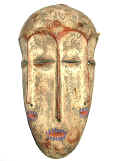
Do ceremonial mask.
The Islamized communities who
live as traders and artisans among non-Moslem groups in extensive areas of
northern Côte d'Ivoire are known for an institution called Do or
Lo, one of whose most striking public manifestations is colorful
masquerade dancing. These masks are danced during the funerals of
distinguished Moslem holy men, and their performances also mark critical
moments during the Muslim calendar year, and at the end of Ramadan, the
month-long Islamic fast. The masqueraders are greatly admired for the grace
of their dance movements, which they perform in pairs and in perfect unison.
The performance of the maskers is
accompanied by drums, singing and dancing, it expresses the joy of the
faithful that the period of fasting is over. Prayers and sacrifices
alternate for a full week before the assembled village.
Material: wood
Size: 13" x 8" x 3" |
|
LOBI
Burkina Faso, Côte d’Ivoire
and Ghana
The Lobi people number 160,000 to 300,000.
Avoiding contact with Europeans, for a long time they escaped
ethnographic observation, and their sculpture was not completely
discovered until 1950s. Very few Lobi have converted to
either Christianity or Islam. Their land is well watered and sparsely
forested, with enough seasonal rainfall to grow sorghum, millet and
corn, and root crops such as yams. The men work the fields, but it is
the women who sow and carry the ears of corn in large baskets on their
head. They raise cattle and many kinds of poultry, primarily used for
sacrifices and for payment of the bride price.
During the wet season when they are not in the
fields, the men work wood and iron, labor in the foundry, and build
houses. The Lobi were
not familiar with centralized authority but were organized in groups of
patrilineal and matrilineal clans. They revere spirits known as
thil. These thil communicate
religious laws to the community through diviners, and these laws govern
the community.
Sculptors, who live off farming, devote
only part of their time to sculpture; their period of apprenticeship may
be reduced, so that the objects are of variable quality, often quite
mediocre. The Lobi do not use masks, but create male and female spirit
figures called bateba and heads
sculpted on top of a post planted in the ground. Bateba is
considered as a living being and may see, communicate, and intervene on
behalf of its thil spirit. Lobi figures are between 2” and
35” high. In every house a small shrine room is set apart
for the worship of ancestral spirits. Shrines are built to
the thil spirits under the instructions of a sorcerer and are
filled with a variety of wooden statues together with
assortment of clay sculptures, iron staffs, bottles, pots and the like.
Frequent sacrifices are made at these shrines to ensure the goodwill of
the ancestors, and to avoid Illness and misfortune.
The figures, associated with the dead, are beings that
are somewhere between spirits and people and may represent the dead, or
ghost, or bush spirit. The figures preside over foundation
rites, essential for obtaining protection for new homes. They were also
used by soothsayers and by the leaders of the family cult.
Large heads depicted on a post or stake form a
unique category of Lobi sculpture. Many examples are sculpted with great
care and attention to detail, and, unlike the full-bodied figures, they
often show a triple scarification at the temple. These sculpted heads
were fixed into the ground at various shrines and in the open air. They
are found with their spike set into the top of an external wall, where
they served as guardians of the house.
The Lobi also produce seats with three feet,
sometimes decorated with a human or animal figure. Lobi arts also
include a wide variety of small human and animal images, implements, and
more abstract symbols in copper alloy and iron. Some of these are worn
as jewelry and some appear on shrines.
|
|
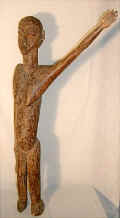
Spirit
Figure (bateba). The
300,000 Lobi are a farming people who live in southwestern Burkina Faso,
northern Côte d'Ivoire and northwestern Ghana. They have no
system of chiefs or other rulers whatsoever. The Lobi consult a diviner to
discover the cause of a problem they cannot solve and the means by which to
remedy it. The diviner is not told the client’s problem; rather, he must
contact the thila (divinities) to identify the misfortune and to
ascertain which thil caused it. The appropriate thil reveals
the cause and prescribes the remedy. The remedy usually entails providing an
altar in the client’s home for the thil on which a figure called
bateba will be placed. Among the bateba are ti bala, or
“extraordinary persons,” of which this female figure is an example. Ti
bala manifest physiological characteristics that are not normally found
in human beings: having more than one body on one pair of legs, having a
head on a leg, or having only one arm, such as with this example. According
to the Lobi these statues are living beings which can move, speak to each
other and even die when their bodies have decayed too far.
Material: wood
Size:
30" x 14" x 2" |
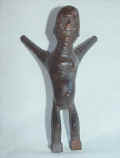
Spirit Figure (bateba).
Avoiding contact with Europeans, for a long time the Lobi people escaped
ethnographic observation, and their sculpture was not completely discovered
until 1950s.
In every Lobi house a
small shrine room is set apart for the worship of ancestral spirits. Here
are placed a variety of wooden statues together with assortment of clay
sculptures, iron staffs, bottles, pots and the like. Frequent sacrifices are
made at these shrines to ensure the goodwill of the ancestors, and to avoid
illness and misfortune. The spirits are represented by figures like this
one, called bateba. Its function may be to provide for the fertility
of the owners wives and livestock and fields and for the general well-being
of the community.
Material: wood
Size:
8" x 5" x 4" |
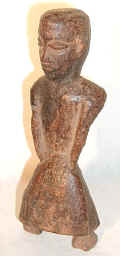
Spirit Figure (boteba).
The 300,000 Lobi are a farming people who live in southwestern Burkina Faso,
northern Côte d'Ivoire
and northwestern Ghana. They have no system of chiefs or other
rulers whatsoever. The community is formed around divinities or thila
(singular thil) rather than a political leader. These thila
communicate religious laws to the community through diviners, and these laws
govern the community. Very few Lobi have converted to either Christianity or
Islam. The divinities are represented by figures like this one, called
boteba. Its function may be to provide for the fertility of the owners
wives and livestock and fields and for the general well-being of the
community. These figures are placed on shrines in a dark corner of the
owner’s house.
Material: wood
Size:
9" x 4" x 2" |
|
LUBA (BALUBA, KALUBA, LOUBA, URUWA,
WALUBA, WARUA)
Democratic Republic of the Congo
The Luba number 1 million. The vast Luba
territory, comprising the entire southeastern part of the DRC, as
far as Tanganyika and Lake Mweru, is uniform as regards language and
culture, but racially mixed. Although the history of the Luba people is
one of violence and warfare, their artistic style is characterized by
harmonious integration of organically related forms. The splendid
artistic achievements of the Luba are due to a felicitous intermingling
of different racial and cultural elements, and to the high standards
prevailing at the court. Luba arts counts amongst the finest that Africa
has to offer. Artists occupied a privileged place in the hierarchy. The
Luba artist carried a ceremonial ax on his shoulder, an emblem of
prestige and of dignity of his position. Some apprentices would be
recruited from among the deformed, who could neither hunt nor be
warriors and who were believed to have a close connection with magic.
Among the characteristics of Luba sculpture are: intricate
hair-dress, often in the form of a cross, or falling down like a
cascade; a grooved diagonal band separating the hair-line from the
forehead; eyes shaped like coffee-beans; small simplified ‘cat’s ears’;
ornamental cicatrices in relief on the body; the surface elaborately
worked and polished. The traditional carvings are for ancestor and
spirit cults, for initiation, medical and divination purposes. The
favorite theme in sculpture was woman since, according to the Luba myth,
vilie was the first woman spirit,
founder of the clan and guarantor of fertility and the lineage. Women
were cult guardians, and the royal wives played an important role: sent
as emissaries to the chiefs of neighboring ethnicities, they would
contract profitable political alliances based on marriage. Some figures
are freestanding, almost always in a frontal position, often with their
hands on their breasts; others are kneeling, sitting, or standing
figures whose upraised hands serve as supports for bowls, seats, and
neck rests. The figures are often characterized by elaborate
scarification patterns on the body. The diviner, painted white, used the
mboko, a seated or crouched female figure holding a bowl robbed
with kaolin. He would shake her and analyze the position of the
different objects the bowl contained. In the healing ritual, the
sorcerer would use the kabila, or daughter of the spirit, which
consisted of a figure and receptacle, which were also placed at the
entry to the house during the childbirth. The female figures are modeled
in rounded forms and have what is called dodu; that is, a
stylistic tendency toward plumpness. One well-known Luba sub-style has
been called the "long-face style" of Buli. It contrasts strongly with
the roundness of other Luba figures. The faces are elongated, with
angular, elegant features. Many Luba statues also carry magic
ingredients on the top of the head.
Of the several mask types used by the Luba,
one of the better known is kifwebe, a mask elaborated with
whitened parallel grooves on a dark ground. The kifwebe masks,
used by the secret society of the same name, originated in this
territory. The Luba attribute its origins to three spirits, which
emerged from a ditch near a lake. The female spirit was attracted by
humans and went to live among them. The two male spirits stayed in the
bush, but visited the village where they dazzled the inhabitants with
their dancing to the point where the men begged to be initiated. These
distinctive masks vary a great deal but in general are characterized
by lineal patterns all over the face. They were worn with a raffia
costume. Danced in male/female couples and representing spirits,
kifwebe connect this world and the spirit world. They are used to
mark important periods of social transition and transformation,
appearing at the death of a chief or any other eminent person, or when a
person assumes an important political title. Worn on the night of the
new moon, they are also performed in honor of ancestors. They also are
perceived as having healing abilities. Examples of large round
kifwebe masks with broad noses, rectangular mouths, and flattened
crests, entered European collections by the second half of the
nineteenth century. During the first two decades of the twentieth
century, the kifwebe masking tradition spread throughout the Luba
and Songye regions of southwest DRC. Female masks are distinguished from
male masks by geometric patterns that represent beauty, including dots,
crosses, chevrons, and triangles.
Entirely different are Luba masks with curved ram’s horns.
Luba circular stools, carved from one
tree trunk are of high artistic merit. They are usually supported by a
caryatid figure of a kneeling or standing woman, the sit resting on her
head and also supported by upraised arms. The headrests are also of
great variety. The Luba produced ceremonial staffs and scepters of very
great variety and beauty. Similar care is shown in adze and axe handles,
with the blade inset like a tongue, arrow quivers, etc. In Luba
sculpture, one also finds drums, pendants, shields, bellows, and pipes. |
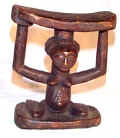
Headrest.
The vast Luba
territory comprises the entire southeastern part of the DRC, as far as
Tanganyika and Lake Mweru. While not an object exclusively limited to royal
use, headrests were prized possessions of Luba chiefs.
Wooden headrests are used as pillows to preserve intricate coiffures. Some
hairdos took up to fifty hours to complete. Using a headrest allowed the
hairdo to last two or three months. In addition to the great personal
attachment that Luba people developed for their headrests, these were also
seen as the seat of dreams. Luba consider dreams to be prophetic: dreams
foretell important events, provide warnings and communicate messages from
the other world. It is therefore fitting that headrests should be supported
by the female priestesses who serve in real life as intermediaries and
interlocutors for the spirits of the other world.
Material: wood
Size:
6" x 6" x 4" |
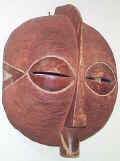
Female Kifwebe mask. The Luba
attribute the origins of the kifwebe society to three spirits, which
emerged from a ditch near a lake. The female spirit was attracted by humans
and went to live among them. The two male spirits stayed in the bush, but
visited the village where they dazzled the inhabitants with their dancing to
the point where the men begged to be initiated. The grooves marking the
surface of kifwebe refer to the ditch from which the founding spirits
emerged. The masks
therefore are marked with signs of the portal to the other world.
During the first two decades of the
twentieth century, the kifwebe masking tradition spread throughout
the Luba and Songye regions of southwest DRC. They were worn in male/female
pairs for royal ceremonies, on the night of the new moon when ancestors are
honored, during initiation and funeral ceremonies, and when a person assumed
an important political title. They also are perceived as having healing
abilities. These
masks were worn with a raffia costume.
Examples of the round kifwebe masks
entered European collections by the second half of the nineteenth century.
Female kifwebe masks differ by smaller crests or even by lack of
them.
Material: wood
Size:
28" x 21" x 12"
|
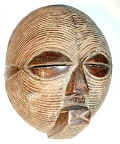
Female Kifwebe mask. The Luba
attribute the origins of the kifwebe society to three spirits, which
emerged from a ditch near a lake. The female spirit was attracted by humans
and went to live among them. The two male spirits stayed in the bush, but
visited the village where they dazzled the inhabitants with their dancing to
the point where the men begged to be initiated. The grooves marking the
surface of kifwebe refer to the ditch from which the founding spirits
emerged. The masks
therefore are marked with signs of the portal to the other world.
During the first two decades of the
twentieth century, the kifwebe masking tradition spread throughout
the Luba and Songye regions of southwest DRC. They were worn in male/female
pairs for royal ceremonies, on the night of the new moon when ancestors are
honored, and during initiation and funeral ceremonies. They also are
perceived as having healing abilities.
These masks were worn with a
raffia costume. Examples of the
round kifwebe masks entered European collections by the second half
of the nineteenth century. Female kifwebe masks differ by smaller
crests or even by lack of them.
Material: wood
Size:
12" x 9" x 6" |
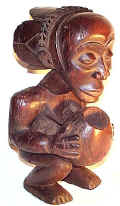
Female bowl bearer (Mboko).
The vast Luba territory, comprising the
entire southeastern part of the DRC, as far as Tanganyika and Lake Mweru, is
uniform as regards language and culture, but racially mixed.
Designed to forecast future events, the bowl bearer – known as a
mboko (the name for the sacred vessel held by the figure) – is a vivid
example of how knowledge and divination are visualized in Luba culture. Luba
bowl figures commemorate the first mythical Luba diviner, Mijibu wa Kalenga,
and were primarily the preserve of royal diviners who used them as oracles.
More recently, such works have also been commissioned by rulers for use as
containers filled with sacred chalk (kaolin), an empowering material
associated with purity, renewal, and the spirit world. They were
sometimes kept at the door of the royal residence.
Visitors were expected to take the kaolin
to smear on their chests and arms, and to spread on the ground before the
king as a gesture of respect. One well-known Luba sub-style has been called
the "long-face style" of Buli. It contrasts strongly with the roundness of
other Luba figures. The faces are elongated, with angular, elegant features.
This figure is a good example of this style.
Material:
wood
Size:
21" x 11" x 10" |
|

Bow stand.
Bow stands were among the most sacred regalia in the treasures of Luba
kings and chiefs. These objects with their three projecting wooden
branches functioned as resting stands for bows and arrows, but were
primarily symbols of royal authority. Never displayed in public, bow
stands were fastidiously guarded in the king’s shrine by a female
dignitary called the Kyabuta, who, at public ceremonies, followed the
chief holding a simple bow between her breasts, becoming a living bow
stand. Only the king and one official had access to this shrine. These
precautions were taken not only to ensure against theft, but to protect
viewers from the tremendous power of the objects.
Material: wood
Size:
39" x 12" x 4"
|
 Female
Figure Female
FigureMAterial: wood
Size: 29" x 9" x 7" |
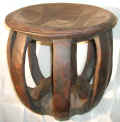
Stool. In
addition to the caryatid stools, Luba have produced nonfigurative stools.
This one is an example.
Material: wood
Size:
20" x 20" x 20" |

Staff of office. African staffs of office have many roles and
functions, as symbols of office and as metaphorical extensions of the hand.
But for Luba people, staffs also function as visual records of the details
of family history, migration, and genealogy. High-level office holders carry
staffs to public proceedings and perform historical recitations to honor
ancestors and teach their descendants about family ties to Luba kingship.
The word “kingship” cannot accurately portray the true nature of Luba
royalty, which was based on the duality of the sexes. The pervasive
representation of women on male officeholders’ emblems, and the important
role of women in Luba political and religious history as spirit mediums,
reinforce the ambiguous gendering of power. (If the women look in
different directions:). Material: wood, metal, metal coil
Size:
56" x 4"
|
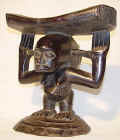
Headrest.
The vast
Luba territory comprises the entire southeastern part of the DRC, as far as
Tanganyika and Lake Mweru. While not an object exclusively limited to royal
use, headrests were prized possessions of Luba chiefs.
Wooden headrests are used as pillows to preserve
intricate coiffures. Some hairdos took up to fifty hours to complete. Using
a headrest allowed the hairdo to last two or three months. In addition to
the great personal attachment that Luba people developed for their
headrests, these were also seen as the seat of dreams. Luba consider dreams
to be prophetic: dreams foretell important events, provide warnings and
communicate messages from the other world. It is therefore fitting that
headrests should be supported by the female priestesses who serve in real
life as intermediaries and interlocutors for the spirits of the other world.
Material: wood
Size:
11" x 11' x 7"
|
|
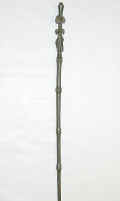
Staff of office. African staffs of office have many roles
and functions, as symbols of office and as metaphorical extensions of
the hand. But for Luba people, staffs also function as visual records of
the details of family history, migration, and genealogy. High-level
office holders carry staffs to public proceedings and perform historical
recitations to honor ancestors and teach their descendants about family
ties to Luba kingship. The word “kingship” cannot accurately portray the
true nature of Luba royalty, which was based on the duality of the
sexes. The pervasive representation of women on male officeholders’
emblems, and the important role of women in Luba political and religious
history as spirit mediums, reinforce the ambiguous gendering of power. (If
the women look in different directions:). This staff, with its
portrayal of a woman, expresses the Luba belief in women’s powers to
bridge both worlds and to mediate between kings and spirits.
Material: wood
Size: 35" x 3" |
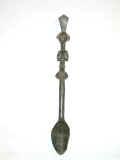
Spoon.
Luba art is a court art that
endowed everyday objects with a stamp of luxury and prestige – stools,
staffs, arrow carriers, headrests, and others. The typical Luba figure is
female with rounded features and soft, sensitive forms. This spoon is one of
such objects.
Material: wood
Size: 18" x 3" x 1" |
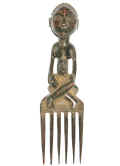
Comb.
The splendid
artistic achievements of the Luba are due to a felicitous intermingling of
different racial and cultural elements, and to the high standards prevailing
at the court. Luba arts counts amongst the finest that Africa has to offer.
The favorite theme in sculpture was
woman since, according to the Luba myth,
vilie
was the first woman spirit, founder of the clan and guarantor of fertility
and the lineage. Women were cult guardians, and the royal wives played an
important role: sent as emissaries to the chiefs of neighboring ethnicities,
they would contract profitable political alliances based on marriage. Therefore
iconographic representation of women in Luba sculpture is widespread and
correlates to the important role of women in Luba society. The Luba are best
known for their carved stools, divination bowls (mboko), bow stands,
standing and sitting woman figures, combs, and others. Elaborately carved
and decorated combs in a rich array of forms are worn as hair ornaments.
This comb is one of them.
Material: wood
Size:
NOT FOUND |
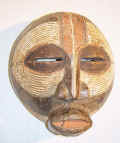
Female Kifwebe
mask. The Luba attribute the origins of the kifwebe society
to three spirits, which emerged from a ditch near a lake. The female spirit
was attracted by humans and went to live among them. The two male spirits
stayed in the bush, but visited the village where they dazzled the
inhabitants with their dancing to the point where the men begged to be
initiated. The grooves marking the surface of kifwebe refer to the
ditch from which the founding spirits emerged.
The masks therefore are marked with signs of the portal to the other world.
During the
first two decades of the twentieth century, the kifwebe masking
tradition spread throughout the Luba and Songye regions of southwest DRC.
They were worn in male/female pairs for royal ceremonies, on the night of
the new moon when ancestors are honored, during initiation and funeral
ceremonies, and when a person assumed an important political title. They
also are perceived as having healing abilities.
These masks were worn with
a raffia costume.
Examples of the round kifwebe masks
entered European collections by the second half of the nineteenth century.
Female kifwebe masks differ by smaller crests or even by lack of
them.
Material: wood
Size:
10" x 9" x 3" |
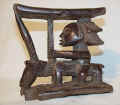
Headrest.
This object destined to support the neck and to protect the sleeper’s very
sophisticated coiffure. Some hairdos, like this
type of “pagoda” coiffure, took up to fifty hours to complete. Using a
headrest allowed the hairdo to last two or three months. This headrest
comprises the figure of a rider mounted
on what appears to be a long-horned antelope, or even a goat. He stretches
out his arms to grasp a supplemental element of support implanted in the
animal’s neck.
While not an object
exclusively limited to royal use, headrests were prized possessions of Luba
chiefs. In addition to the great
personal attachment that Luba people developed for their headrests, these
were also seen as the seat of dreams. Luba consider dreams to be prophetic:
dreams foretell important events, provide warnings and communicate messages
from the other world.
Material: wood
Size:
7" x 6" x 3" |
|
|
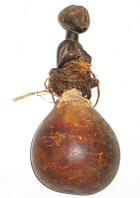
Female Figure on a Gourd
A wooden female figure seated on top of a gourd functioned as a nkisi (a
fetish). A Bilumbu - a spirit medium would utilize such objects for
divination and healing. They may also be used for retrieving lost articles,
curing sterility and revealing prophecy through dreams.
Materials: wood, gourd, seeds, plant
fiber, rope.
Size: 10" x 5" x 5" |
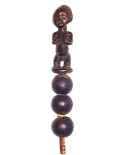
Female divination rattle
Kibuta or divination has been an important part of Luba way of life.
This rattle is a nkisi - a female figure atop of 3 small gourds. A
Bilumbu diviner would rattle the seeds in the three small gourds, while
performing the divination for help with locating misplaced objects,
curing sterility and attaining general well-being.
Materials: wood, small gourds/seeds
Size:
10" x 2" x 2"
|
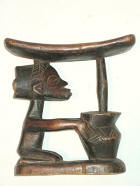
Headrest.
Using a headrest allowed the hairdo to last two
or three months.
Headrests were prized
possessions of Luba chiefs. In
addition to the great personal attachment that Luba people developed for
their headrests, these were also seen as the seat of dreams. Luba consider
dreams to be prophetic: dreams foretell important events, provide warnings
and communicate messages from the other world. This headrest rests on the
head of a kneeling male who is stretching his hands out to a large
ceremonial vessel. The vessel and the forehead of its user are decorated
with an ornament.
Material: wood Size:
7" x 6" x 3" |
|
LULA
Democratic Republic of the Congo
The 15,000 Lula settled along the banks of the Nseki River.
Today they live in autonomous villages and their economic survival
depends on hunting and fishing. Stylistically, their statues show Teke-like
facial scarifications, while the carved coiffure and the general
morphology of the figures are influenced by the Yaka. The Lula carved
small apotropaic figures (25 cm high) and prestige objects such as
flywhisks and headrests. In the 1980s, Lula masks first appeared in the
West. They are covered with blue and white pigments and have oblong
shape and typical rounded eyes. They are thought to have been worn by
the guardian of the initiation camp. (adapted from J.-B. Bacquart, The
Tribal Arts of Africa, Thames and Hudson, N. Y., 1998)
|
|
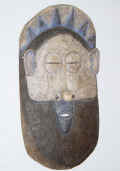
Initiation mask.
Migrating with the Yaka people from Angola during 16th
century, the 15,000 Lula settled along the banks of the Nseki River in
Haut-Zaire Region. Today they live in autonomous villages and their
economic survival depends on hunting and fishing. Stylistically, they
are under influence of Teke and Yaka. In the 1980s, Lula masks first
appeared in the West. They have an oblong shape and typical rounded
eyes. They are thought to have been worn by the guardian of the
initiation camps. Lula artists used white and blue pigments to
accentuate shapes and surfaces on their masks.
Material: wood
Size:19" x 10" x 10" |
|
LULUA
Democratic Republic of the Congo
Lulua is an umbrella term, which refers to a large number of
heterogeneous peoples who populate the region near the Lulua River,
between the Kasai and Sankuru rivers. The Lulua people migrated from
western Africa during the 18th century and settled in the southern part
of the Democratic Republic of the Congo (formerly Zaire). They number
300,000 and live in small regional chiefdoms and in times of crisis
elect a common leader. The role of the village chief is to insure
juridical, political and social cohesion. During the late 19th century,
Lulua culture underwent radical changes. In 1875, the Lulua king,
Kalambam, introduces new social and religious regulations, which ended
the traditional palm-wine drinking and hemp smoking.
Their economy is mostly based on agriculture, hunt and trade.
Primarily farmers, Lulua women grow manioc as a staple crop, as well as
beans, sweet potatoes, maize, yams, peanuts, and bananas. The men are
responsible for clearing the forest and preparing the soil for
cultivation. They also hunt, fish with nets, and trap animals in the
surrounding forests. Salt is found in the region and is collected and
sold to neighbors to generate income.
The Lulua statuary is remarkable in the degree of its
scarification, a manifestation of a wish to be socially differentiated.
These marks must be very ancient as in 80th of 19th
century they were no found on the Lulua themselves. The statues
represent great chiefs with beards and insignia, and these effigies
would be planted in the ground to protect the household when the head of
the family was absent. These male figures depict warriors-chiefs who
often hold a ceremonial sword and shield, or a cup. Sometimes knives and
other paraphernalia hang from the belt. The most famous statuettes are
the mbulenga, or female charm statuettes. The chibola are
maternity figures that, when worn on the belt, protected the newborn
child or the baby about to be born: the chibola would stand watch
over childbirths. The protruding abdomen of the woman emphasizes the
importance of the lineage.
Other figures are in crouching or squatting positions with
raised hands resting on the neck and the oversize head. It is said that
this position corresponded to the burial form, and in all probability
these statues represent ancestors. Other statuettes with truncated bases
protected against sorcerers, thieves, and lightning; they were used in
divination sessions, and could bring about bad luck. Crouching figures
with receptacles on their heads were used as hemp boxes by the hunters,
who attached them to the belt and spoke to them, and they brought him
luck on his return. During the hunting ritual, the statue would be fed
and placed on a small earth hillock to witness the hunt. Warrior statues
are also numerous. Large standing figures, carrying a cup, were charms
of beauty and luck inhabited by ancestral spirits. These statues
participated in the investitures of chiefs and at their funerals. One
should note the importance of the head, which frequently comprises a
quarter of the total dimension of the figure. The hairdos generally end
in a point and have tufts of hair emerging from the back of the skull.
The horn projected from the top of the head symbolizes power. The neck
is long, the shoulders tattooed, the breasts small and pointy. The
position of the arms at right angles expresses virile strength. The
navel is often pointed, surrounded by concentric circles that symbolize
life. The legs are short.
As for Lulua masks, the heterogeneous
composition of the people and the considerable area they occupy, explain
the many stylistic overlappings with their neighbors. The formal and
functional diversity of the masks testifies to the region as an ethnic
crossroads and sometimes makes it difficult to confirm their origin. One
can distinguish at least two categories of wooden Lulua masks. The first
group consists of face masks with concave eye-sockets and intricate
geometric painted patterns; the second consists of face masks with
concave eye-sockets, simpler patterns, and plank-shaped crest. Lulua
masks with their pointed nose and deep eye-sockets were probably used
during circumcision and funeral ceremonies.
The Lulua also make pipes, tobacco mortars, neck-rests, hemp
jars, drums, combs, small hunters’ flutes, and adzes. |
|
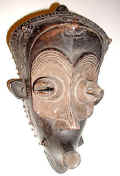
Initiation
Spirit Mask.
The Lulua
numbering 300,000 inhabit a vast region in the south central
DRC. They live in small relatively
independent regional chiefdoms. Lulua women grow manioc as a
staple crop, as well as beans, sweet potatoes, maize, yams, peanuts, and
bananas. The men are responsible for clearing the forest and preparing the
soil for cultivation. They also hunt, fish with nets, and trap animals in
the surrounding forests. The Lulua were never politically united and
therefore there were a large number of relatively autonomous chiefs, which
meant that many local dignitaries had works of art dedicated to them. The
heterogeneous composition of the Lulua, and the considerable area they
occupy, explain the many stylistic overlapping with their neighbors.
Lulua art is
very personal and has very little relation to neighboring styles.
The Lulua masks representing the
spirits of the dead are used by masqueraders who perform during circumcision
rites in initiation ceremonies. They have recently been danced to celebrate
the founding of a new mission post or hospital and to entertain occasional
visitors.
Material: wood
Size: 15" x 8" x 5" |

Female figure. The Lulua are a patrilineal Bantu-speaking
people who inhabit a vast region in the province of West Kasai in the south
central DRC. Lulua art is very personal and has little relation to
neighboring styles. The subjects are men, women, and
mother-and-child-groups. The body is covered with elaborate scarification
marks. Body decoration is a peculiar trait of Lulua sculpture, and echoes a
cosmetic practice widespread among the women of the upper class. Figures of
mothers with children or of pregnant women, like this one, are associated
with the fertility cult, and were sculpted for mothers who had aborted or
had continually lost children on the suggestion of the priest-healer, in
order to encourage normal pregnancies. The tattoos, considered signs of
beauty, indicated the high position of woman in society.
Material: wood
Size: 23" x 5" x 4" |
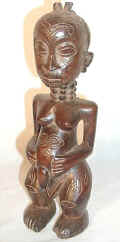
Female chibola figure.
Lulua is an umbrella
term, which refers to a large number of heterogeneous peoples who populate
the region near the Lulua River, between the Kasai and Sankuru rivers. The
Lulua statuary is remarkable in the degree of its scarification, a
manifestation of a wish to be socially differentiated. These marks must be
very ancient as in 80th of 19th century they were no
found on the Lulua themselves.
The
chibola are maternity figures that, when worn on the belt, protected the
newborn child or the baby about to be born: the chibola would stand
watch over childbirths. The protruding abdomen of the woman emphasizes the
importance of the lineage.
Material: wood
Size: 9" x 3" x 3"
|
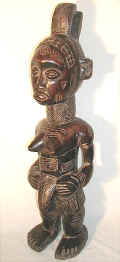
Female chibola figure. The Lulua practiced the cult of
Bwanga Bwa Cibola which was thought to help women who suffered repeated
still-births or lost several children shortly after birth. An act of sorcery
was blamed, and the woman consulted a diviner. The diviner advised the woman
to have herself initiated into the bwanga cult which involved a
certain number of dietary taboos and other prohibitions. The initiate was
given a statuette depicting a pregnant woman or a maternity statue. She went
on to live in a small dwelling outside the village. Like the other Lulua
sculptures this figurine is covered with rich scarifications, which the
Lulua see as tokens of beauty. Standing statues were placed in a basket by
the woman’s bed.
Material:
wood
Size: 30" x 7" x 8" |
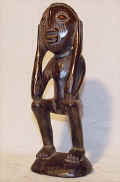 Ceremonial
female. The name of this tribe
derives from the name of the Lulua River (in the south central DRC), which
they inhabit. Numbering 300,000
they live in small regional chiefdoms. The Lulua were never
politically united and therefore there were a large number of relatively
autonomous chiefs, which meant that many local dignitaries had works of art
dedicated to them. The Lulua are a patrilineal
Bantu-speaking people who inhabit a vast region in the province of West
Kasai in the south central DRC. They devote themselves mostly to the hunt.
Lulua art is very personal and has little relation to neighboring styles.
The subjects are men, women, and mother-and-child-groups. The crouching
figures are thought to be associated with disease and suffering. Ceremonial
female. The name of this tribe
derives from the name of the Lulua River (in the south central DRC), which
they inhabit. Numbering 300,000
they live in small regional chiefdoms. The Lulua were never
politically united and therefore there were a large number of relatively
autonomous chiefs, which meant that many local dignitaries had works of art
dedicated to them. The Lulua are a patrilineal
Bantu-speaking people who inhabit a vast region in the province of West
Kasai in the south central DRC. They devote themselves mostly to the hunt.
Lulua art is very personal and has little relation to neighboring styles.
The subjects are men, women, and mother-and-child-groups. The crouching
figures are thought to be associated with disease and suffering.
Material: wood
Size: 22" x 4" x 4"
|
|
LWALWA
(BALUALUA, BALWALWA, LWALU)
Democratic Republic of the Congo and
Angola
Lwalwa people are related to Lulua.
Inhabiting the triangle formed by the Kasai River and its
tributary, the Lweta, in the southwest of the former Kasai province,
20,000 Lwalwa live in DRC, but many more are in Angola. Their social and
political organization is rudimentary. Each Lwalwa village is
headed by a male or female chief, whose power is held in check by a
powerful society, the bangongo. The
Lwalwa believe in a supreme being, but they worship only the spirits of
the hunt and nature. The land where the Lwalwa live is rich and
fertile, lending itself well to the agricultural economy of the people.
The women are almost wholly responsible for all that goes into the
growing of crops, both for local consumption and for trade. The men do,
however, lend a hand during the busy harvest time, so that they can
evaluate their household intake for the season. Although hunting by the
men provides some occasional supplementary protein, the women provide
the majority of the nutritious intake. The hunt, sometimes individual
and sometimes communal, still plays an important social role among the
Lwalwa.
The sculptor enjoyed a privileged status and
was paid handsomely; his profession was hereditary and often, due to his
riches, he was made village chief in charge of the masked dances.
Lwalwa carvers are famous for their masks. The masks typically
display a balanced composition, an enlarged angular nose, a protruding
mouth and slanted eyes set under a deeply formed forehead. These sharply
delineated features give Lwalwa art almost geometric appearance.
The masks may be divided into four types: the nkaki, or
man’s mask, with a nose sculpted into a wide triangular panel that
sometimes extends up to the forehead; the shifoola, a mask with a
short, hooked nose; the mvondo, the nose of which is reminiscent
of the nkaki’s, but smaller; and finally the mushika or
kashika, which represents a woman and which has a frontal crest. The
shapes of the nose are modeled after different birds. The lips are
narrow but protruding and thick; the eyes have openings in horizontal
slits. On the temples they have a protuberance that represents
tattooing. The masks had an important function in the bangongo
dance of the hunting ritual. When hunters returned empty-handed, the
ancestors would be appeased by organizing a dance. The masks were also
used in a secret ritual of the bangongo society, in
charge of initiation and circumcision of young men. The choreography of
masked dances was highly complex and had to appease the spirits of the
ancestors and compel them to intervene. Masks still play a role today in
secular festivities. Nowadays the mask dances are performed for
payment, and their magic has largely given way to entertainment.
The statuary limited to rather crude figurines
whose features are copied from masks, played a definite role in the
fertility ritual and also in the cult devoted to the spirits. |
Male nkaki
ceremonial mask. The land where 20,000 Lwalwa live is rich and
fertile, lending itself well to the agricultural economy of the people.
Lwalwa art, known mostly by the masks, is the most original in a group of
tribes located in the region where the Kasai River marks the border between
Zaire and Angola. Sculpting is recognized as a prestigious profession and is
usually passed on from father to son. Sculptors are a privileged caste of
the comm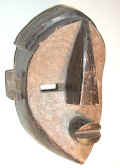 unity and the Lwalwa are renowned dancers. Masks play an important
role in the lives of the Lwalwa. There are four types of masks, three
masculine and one feminine. The masks had an important function in the
bangongo dance of the hunting ritual. When hunters returned
empty-handed, the ancestors would be appeased by organizing a dance.
The masks were also used in a secret ritual
of the bangongo society, in charge of initiation and
circumcision of young men. The choreography of masked dances was highly
complex and had to appease the spirits of the ancestors and compel them to
intervene. Masks still play a role today in secular festivities. unity and the Lwalwa are renowned dancers. Masks play an important
role in the lives of the Lwalwa. There are four types of masks, three
masculine and one feminine. The masks had an important function in the
bangongo dance of the hunting ritual. When hunters returned
empty-handed, the ancestors would be appeased by organizing a dance.
The masks were also used in a secret ritual
of the bangongo society, in charge of initiation and
circumcision of young men. The choreography of masked dances was highly
complex and had to appease the spirits of the ancestors and compel them to
intervene. Masks still play a role today in secular festivities.
Material: wood
Size: 14" x 9" x 7" |

Ceremonial Figurine. The statuary
limited to figurines whose features are copied from masks, played a definite
role in the fertility ritual and also in the cult devoted to the spirits and
ancestors. No details concerning Lwalwa figures are known.
Material: wood
Size: 17" x 3" x 3"
|
|
LWENA
LWENA (ALUENA,
KALUENA, LOVALE, LUENA, LURALE, WENA)
Angola,
Democratic Republic of the Congo and Zambia
This primarily Angolan tribe lives partially in DRC and in
Zambia. Led by a king, the Mwana Yamvo,
the Lwena people support themselves from fishing in the wet plains at
the source of the Zambeze River, in Angola. The structure of Lwena art
is largely based on that of the Chokwe, but includes a more refined use
of full, round shapes, and differ also by the coiffures and
scarifications on the cheeks and forehead. Artistically, the Lwena
appear to have focused their skills on carving female figures, which are
also found on decorative ‘prestige’ objects such as canes, combs and
finger pianos, and on masks. These differ from those of the Chokwe as
their statues usually display a spherical cross-hatched coiffure which
is often divided by a vertical ridge, and angular linear scarifications
on their cheeks. All in all, it is a very female art related to a tribal
social structure in which women play important roles, including that of
chief. |
|
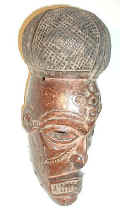
Young woman pwevo
mask.
The structure of Lwena art
is largely based on that of the Chokwe, but includes a more refined use of
full, round shapes. Artistically, the Lwena appear to have focused their
skills on carving masks and female figures. All in all, it is a very female
art related to a tribal social structure in which women play important
roles, including that of chief.
This is a “young woman” mask,
presenting a mythical female personage who died young and whose painful loss
was recalled by the masquerader’s dance. Such masks, danced by men, appear
at various festivities in order to entertain the village, and especially its
female inhabitants, with performances in which sexual references play a key
part. The Lwena style of this mask is indicated mainly by cheek
scarifications and round coiffure.
Material: wood
Size:12" x 6" x 5" |
|
MAKONDE
(WAMAKONDE)
Tanzania and Mozambique
Inhabiting the southeast of Tanzania and
the northeast of Mozambique are about 500,000 Makonde, divided into
matrilineal clans, each one comprising several villages. Decisions are
made by a chief supported by a council. Clan members meet only for the
ancestral cult and to celebrate initiations.
According to legend, shortly after the
Creation, the first man, wandering around outside the bush, sculpted a
female figure out of wood, and the statue became a real woman who gave
him many children and, after her death, became the venerated ancestress
of the Makonde. This accounts for the ancestress cult as well as the
profusion of sculpted female figures, kept in huts.
In the traditional homelands of the Makonde the
primary source of food comes from slash and burn farming. Crops include
maize, sorghum, and cassava. This is often supplemented by hunting.
The precolonial Makonde lived in dispersed
settlements. Each settlement was composed of a small number of
households headed by men belonging to a matrilineal kinship unit called
a likola. A likola was said to derive from a common female
ancestor, revered as a life-giver and protector, who was represented by
figurines only a few inches tall. Carved from soft wood, the images were
embellished with traditional body decoration: the face and torso had
geometrical designs, and the upper lip exhibited the lip-plug worn by
Makonde women of the time. People often carried such carvings with them
on long journeys. For example, a man going out to hunt might have tied
one to his back or hip to protect him from danger. Other carvings served
educational purposes. One of the most important events in the life of a
Makonde was initiation. During this intensive months-long ritual, girls
and boys were provided with knowledge and skills essential to the
Makonde way of life. Carvings sometimes functioned as teaching tools in
the context.
The most important carving used in initiation
ceremonies was the lipiko (or mapiko) mask, which was
worn over the top of the head, tilted back so the wearer could look out
through the mouth. The masks sometimes represent ancestral spirits,
sometimes animals. The ancestors come back masked in order to express
their joy at the successful achievement of initiation. Their presence is
proof of the tight bonds that exist between the living and the dead. The
Makonde masks may attain great expressiveness. Some are simple in form,
with static concave planes; others display an organically sensed rounded
style. The naturalism is exaggerated in many masks, with their full lips
and receding cranium. The faces of the masks are often scarified. The
Makonde have two main types of masks: helmet crests, known as lipiko,
and face masks. The anthropomorphic face masks portray particular
individuals or occasionally represent sickness. Design elements
frequently include scarification marks, and eyebrows, lashes and
coiffure made of real hair affixed with wax. The helmet masks have
strong, Negroid features. Male masks have beards, female ones lip-plugs
and – a travesty of the male dancer – body masks in which two breasts
are depicted in the middle of the wax tattoos. The body masks celebrate
the return of young men to the village after they have been initiated
into adult life. The men who wear them cover their faces with a mask of
a feminine face. They represent pregnant women. The feminine mask dances
with great composure while a masculine mask dramatizes the pains of
childbirth. An orchestra of drummers accompanies the dances. Certain
masks must inspire terror in the women, who may only view their
apparition with their upper body bent over and their head facing down
towards the ground. Animal masks are provided with long ears and horns,
and dancers in ape masks turn acrobatic somersaults.
The Makonde are almost the only ethnicity
in East Africa to create fairly naturalistic sculptures – primarily
maternity figures, which are intended to ensure the fertility of the
fields and women. The upper lip of the female figurine is elongated by a
labret. The standing figures often have the arms separated from the
body. These male and female figures represent ancestors, and have
apotropaic functions. Famous, too, are the milete: small wooden
boxes for medicines, snuff or gunpowder, the lids of which bear pretty
motifs of rosettes and animal figures. |
|
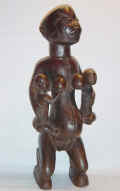
Ancestral Female
Figure.
The 500,000 Makonde are divided into
matrilineal clans, each one comprising several villages. Clan members meet
for the ancestral cult and to celebrate initiations. The Makonde believe in
a world of ancestor spirits and in malevolent spirits who make an appearance
during the ceremonies that close initiation rites. According to legend,
shortly after the Creation, the first man, wandering around outside the
bush, sculpted a female figure out of wood, and the statue became a real
woman who gave him many children and, after her death, became the venerated
ancestress of the Makonde. This accounts for the ancestress cult as well as
the profusion of sculpted female figures, kept in huts.
During this
intensive months-long ritual, girls and boys were provided with knowledge
and skills essential to the Makonde way of life. The Makonde practice of
carving protective ancestor figures predates the colonial era.
Material: wood
Size: 25" x 11" x 9" |
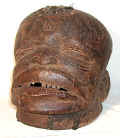
Initiation lipico facemask. The 500,000 Makonde, divided
into matrilineal clans, survive economically from farming and
occasionally, cattle rearing. Makonde carvers are prolific producers of
masks, statues and decorative objects. The most famous are the lipico
masks, which are used to mark a boy’s initiation into adulthood.
Lipico is the name that Makonde men give to the masker of their
masquerading association, who is brought from the bush into the village
for initiation celebrations. . They were worn by the men who directed
the initiation and whose identity was carefully hidden from women and
young boys. It was only revealed to the adolescents at the end of their
initiation, after they had undergone various ordeals. The dances are
accompanied by an orchestra of drummers. These masks have realistic
features.
The hairdo is made of human hair.
The masks are carved with light
balsa-like wood and are always worn with a cloth.
Material: wood
Size: 11" x 10' x 10" |
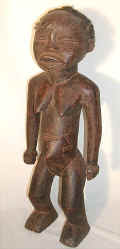
Ancestral Female Figure. The Makonde believe in a world of ancestor spirits and in malevolent
spirits who make an appearance during the ceremonies that close initiation
rites. According to legend, shortly after the Creation, the first man,
wandering around outside the bush, sculpted a female figure out of wood, and
the statue became a real woman who gave him many children and, after her
death, became the venerated ancestress of the Makonde. This accounts for the
ancestress cult as well as the profusion of sculpted female figures, kept in
huts.
During the intensive
months-long initiation ritual, girls and boys were provided with knowledge
and skills essential to the Makonde way of life. The Makonde carver was
first and foremost a farmer, dedicating time to carving only in the
off-season or during periods of rest. The Makonde practice of carving
protective ancestor figures predates the colonial era.
Material: wood
Size: 21" x 8" x 6" |
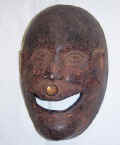
No information exists about this mask
11" x 8" x 6" |
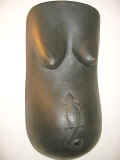
Body mask (Njorowe).
Among the Makonde in southern Tanzania, masquerading is linked with the
initiation of adolescent boys and girls, to prepare them for their future
role as husbands and wives. In the masquerades held at the end of the
isolation period, the actors dance and pantomime relations between the sexes
or embody various characters, each topic being represented by a particular
mask type. In earlier periods, a body plate (njorowe) with breasts,
protruding navel and a bulging belly represented a young, pregnant woman. It
was part of the costume of a male dancer whose face was concealed behind a
female mask. In his performance together with a male mask figure, he moved
sluggishly mimed sexual intercourse with his partner, and demonstrated the
burdens of pregnancy and giving birth. These evocative performances can
still be observed among the Makonde today. The meaning of the scarification
representing a lizard is not clear.
Material: wood
Size: 27" x 14" x 9" |
| |
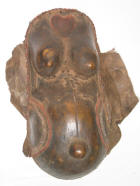
Body mask (Njorowe).
Among the Makonde in southern Tanzania, masquerading is linked with the
initiation of adolescent boys and girls, to prepare them for their future
role as husbands and wives. In the masquerades held at the end of the
isolation period, the actors dance and pantomime relations between the sexes
or embody various characters, each topic being represented by a particular
mask type. In earlier periods, a body plate (njorowe) with breasts,
protruding navel and a bulging belly represented a young, pregnant woman. It
was part of the costume of a male dancer whose face was concealed behind a
female mask. In his performance together with a male mask figure, he moved
sluggishly mimed sexual intercourse with his partner, and demonstrated the
burdens of pregnancy and giving birth. These evocative performances can
still be observed among the Makonde today.
MAterial: Wood, beads, fabric
Size: 24" x 13" x 10" |
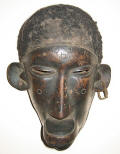
Female face mask.
The Makonde have two mask types: helmet crests, used principally by
the groups in Mozambique, and face masks , prevalent among the Tanzanian
Makonde. The anthropomorphic face masks portray particular individuals or
occasionally represent sickness. Female masks like this one often have a lip
plug, and male masks a beard. This mask is covered with human hair, and
has simple circular scarification. The mask covered the dancer’s head. His
disguise was completed by a costume of fabrics, foliage, or feathers,
supplemented by various accessories such as fly whisks, dance stuffs,
noisemakers, or weapons. The Makonde still hold masquerade dances at the
end of initiation ceremonies, when adolescent boys and girls return from
their separate bush camps after a period of seclusion. In this context the
anthropomorphic masks embody ancestral spirits, whose apparition serves to
remind the initiates of their new position in the community and the rights
and duties it entails.
Material: wood, human hair
Size: 9" x 7" x 4" |
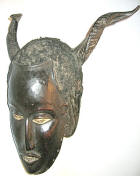
Size: 18" x 11" x 12" |
|
|
MAMA (KANTANA)
Nigeria
The Mama live on the plateaus of northern
Nigeria, extending from the present-day state of Ebbi to the Cameroon
border. Difficulty accessible, this extremely varied region from an
ethnic and linguistic point of view, has in the past been the site of
numerous migrations and invasions.
Geographically isolated, the peoples of
the northeast – Montol, Jukun, Koro, Goemai, Mama, etc – have up to
present been relatively little studied. Nonetheless, among the majority
of these peoples we do find the institution of a chief/priest invested
with sacred authority, one responsible for the well-being of the entire
community. The political organization of the Mama, however, was quite
varied. The plateau region has a long artistic tradition behind it, for
it is here that the Nok civilization blossomed – one that has given us
the most ancient evidence of terracotta figurative sculpture from West
Africa. From an artistic viewpoint, the Mama are producers of rather
abstract statuary, as well as masks that are associated with the world
of the ancestral spirits – spirits who exercise an important function of
social control. One finds the image of the buffalo and the antelope
throughout the whole valley of the Shemankar, among the Mama as among
the Goemai and the Jucun. These animals are closely related to the
material prosperity provided by good harvests. The dance took place
within the framework of the mangam cult. Outside the areas
reserved for the cult, buffalo skulls, occasionally set in mud walls,
prove that the animal, in the form of skulls or masks, played an
important role in the Mama’a ancestor cult. |
|
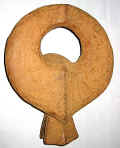
Buffalo spirit mask. The Mama
live on the plateaus of northern Nigeria. Almost inaccessible, this
extremely varied region from an ethnic and linguistic point of view, has in
the past been the site of numerous migrations and invasions. The plateau
region has a long artistic tradition behind it, for it is here that the Nok
civilization blossomed – one that has given us the most ancient evidence of
terracotta figurative sculpture from West Africa. From an artistic
viewpoint, the Mama are producers of rather abstract masks that are
associated with the world of the ancestral spirits – spirits who exercise an
important function of social control. One finds the image of the buffalo and
the antelope among the Mama. These animals are closely related to the
material prosperity provided by good harvests. This mask represents the
stylized image of a buffalo, whose horns form a circle. Inspired on the
living model of a dwarf buffalo, it belongs to the exclusively male
association which have inherited their power directly from the ancestors,
and whose purpose is to maintain social order and agricultural productivity.
An animal of the bush with a most dangerous reputation, the buffalo is often
the image for potency and occult power. The dances where the buffalo
intervenes are often related to human and agricultural fecundity.
Material: wood
Size: 14" x 12" x 3" |
|
MAMBILA
Cameroon and Nigeria
The 25,000 Mambila, farmers and stockbreeders, occupy the region
bordering Cameroon and Nigeria, to the north of Grassland. Land, every
family’s property, is distributed by the group’s chief. The
primary cereal crops include sorghum, rice, and millet. They also grow
bananas, yams, maize, manioc, peppers, peanuts, sweet potatoes, and
tobacco. They acquired the practice of milking cattle from the Fulani
and also use manure from the cattle as fertilizer. Goats, chickens,
dogs, and sheep are raised for meat. Some hunting and fishing is done,
but neither contributes significantly to the daily economy.
Labor is divided between men and women, and children begin to work at
the age of twelve. A society of mutual assistance, the kurum,
participates in clearing land, harvesting, and building houses and
facilitates social contacts during celebrations and dances. The men are
in charge of weaving cotton, metal- and woodworking, and braiding fiber.
Merchants and blacksmiths are separated from the rest of the community.
The trade is passed from father to son. They practice the ancestor cult
and agrarian rites. The Mambila only worshipped family ancestors.
According to their beliefs, at one’s death the ancestors take away the
soul of the deceased during the night. The chiefs of the lineage were
buried in granaries, for they are representative of prosperity and life,
just as the grains of millet.
Mambila art centers upon an association called suaga. It
is primarily concerned with justice and supernatural cleansing within
the community. The Mambila produced a considerable number of figures
that are characterized by a heart-shaped face; pigments are often
applied later. Mambila figures embody ancestors who, according to their
beliefs, are responsible for the clan's wealth. The figures appear with
bent legs and typical enlarged head outlined in wooden pegs. Mambila
also make highly stylized animal masks. Masks and statues were kept
hidden from the eyes of women in a net hung on the inside of a hut that
was on stilts; it was guarded by the head of the family. The front wall
of the hut was decorated with two figures, male on the right and female
on the left, crowned by a rainbow and framed by the sun and the moon.
Dancers celebrating the beginning and end of the agricultural cycle are
led by a tribesman wearing a cephalomorphic helmet mask. He is often
followed by a retinue of assistants wearing secondary masks in the shape
or stylized animal heads, usually dog’s or crow’s. In general, women are
excluded from these masquerades, both as actors and as spectators. Women
dressed in rags and vegetation present their own version of the
masquerade at a different time and place. |
|
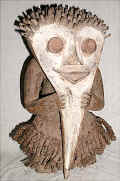
Ancestor spirit figure (tadep).
Some 25,000 Mambila, farmers and stockbreeders, occupy the
region bordering Cameroon and Nigeria, to the north of Grassland. They are
organized into villages without a centralized hierarchical structure. The
Mambila believe that ancestor spirits must intercede to secure the
well-being of the living, who do not address to supreme being directly. They
practice the ancestor cult that gives rise to sculptures in wood and
terracotta. The Mambila are famous for the originality of their sculpture.
Their tadep figures are characterized by a heart-shaped face,
enlarged head, outlined with wooden pegs. They are thought to embody
ancestors who are responsible for the clan’s wealth. The tadep
figures were used in healing rites and to deter thieves. Some sources also
link them to the promotion of fertility.
Material: wood
Size: 15" x 8" x 4" |
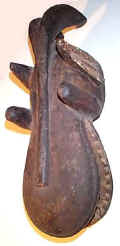
Suah helmet crest.
Some 20 to 25,000 Mambila, agriculturists and stockbreeders,
inhabit the region bordering Cameroon and Nigeria, to the north of
Grassland. Organized into villages without a centralized hierarchical
structure, the Mambila practice the ancestor cult. The chiefs of the lineage
were buried in granaries, for they are representative of prosperity and
life, just as the grains of millet. At regular intervals the Mambila
practice agrarian rites with the intervention of masks from secret
societies. The most important masks used at Mambila celebrations are these
of this type. It represents either a cow called suah duah or a dog
called suah buah. The masks have individual names. Such masks are
worn twice a month at the waxing and the waning of the moon and for the
promotion of the welfare of the community. They were also used at sowing and
harvesting festivals.
Material: wood
Size: 23" x 8" x 8" |
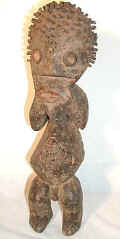
Ancestor spirit figure (tadep).
Mambila ancestral spirits are believed to be instrumental forces in the
welfare of the living. While generally idealized as benevolent and the
source of moral authority, ancestors nevertheless may also have an
ambivalent and fickle quality. Thus, they must be placated and their
goodwill humored to provide the good things in life: fertility, health,
prosperity. Ancestor figures are the concrete adobe for ancestral spirits,
they are offered and treated with magical and medicinal substances to
dispose them well toward their living descendants. The
tadep figures are characterized by a heart-shaped face, enlarged head,
outlined with wooden pegs.
Material: wood
Size: 14" x 4" x 3" |
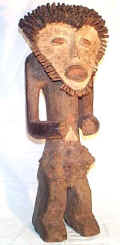
THIS ITEM IS SOLD
Ancestor spirit figure (tadep).
Mambila ancestral spirits are believed to be instrumental forces in the
welfare of the living. While generally idealized as benevolent and the
source of moral authority, ancestors nevertheless may also have an
ambivalent and fickle quality. Thus, they must be placated and their
goodwill humored to provide the good things in life: fertility, health,
prosperity. Ancestor figures are the concrete adobe for ancestral spirits,
they are offered and treated with magical and medicinal substances to
dispose them well toward their living descendants. The
tadep figures are characterized by a heart-shaped face, enlarged head,
outlined with wooden pegs. The tadep figure are kept in family
altars.
Material: wood
Size: 26" x 10" x 9" |
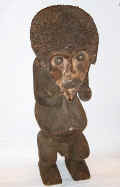
Ancestor spirit figure (tadep).
Some 25,000 Mambila occupy the region bordering Cameroon and
Nigeria, to the north of Grassland. The Mambila believe that ancestor
spirits must intercede to secure the well-being of the living, who do not
address to supreme being directly. They practice the ancestor cult that
gives rise to sculptures in wood and terracotta. The Mambila are famous for
the originality of their sculpture. Their tadep figures are
characterized by a heart-shaped face, enlarged head, outlined with wooden
pegs. They are thought to embody ancestors who are responsible for the
clan’s wealth. They are offered
and treated with magical and medicinal substances to dispose them well
toward their living descendants. The tadep figures
were used in healing rites and to deter thieves. Some sources also link them
to the promotion of fertility.
Material: wood
Size: 39" x 12" x 10"
|
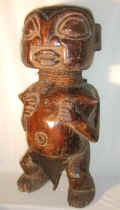 Mambila
(Mambilla)(?), Cameroon & Nigeria Ancestor
guardian figure.
Some 25,000 Mambila,
farmers and stockbreeders, occupy the region bordering Cameroon and
Nigeria, to the north of Grassland. They are organized into villages
without a centralized hierarchical structure. The Mambila believe that
ancestor spirits must intercede to secure the well-being of the living,
who do not address to supreme being directly. They practice the ancestor
cult that gives rise to sculptures in wood and terracotta. The Mambila
are famous for the originality of their sculpture. Such figures served
as guardian figures of the village ancestor house. Another source holds
it is an image of a pygmy. Mambila
(Mambilla)(?), Cameroon & Nigeria Ancestor
guardian figure.
Some 25,000 Mambila,
farmers and stockbreeders, occupy the region bordering Cameroon and
Nigeria, to the north of Grassland. They are organized into villages
without a centralized hierarchical structure. The Mambila believe that
ancestor spirits must intercede to secure the well-being of the living,
who do not address to supreme being directly. They practice the ancestor
cult that gives rise to sculptures in wood and terracotta. The Mambila
are famous for the originality of their sculpture. Such figures served
as guardian figures of the village ancestor house. Another source holds
it is an image of a pygmy.
Material: wood.
Size: 29" x 14" x 13" |
|
MANGBETU
(GURUGURU,
MOMBOUTTOUS, MONBUTTOO, NGBETU)
Democratic
Republic of the Congo
In the middle of the 18th century the Mangbetu people left the
Sudan, they re-located their kingdom in the north-eastern part of the
Democratic Republic of the Congo. Their social structure is not
dissimilar to other Zairian forest-based tribes where the men hunt and
fish, while the women are left to cultivate the fields.
Yams, manioc and plantains are the primary crops, and
some cattle farming is done. Unlike other Sudanic peoples, however,
among the Mangbetu only the men are permitted to do the milking.
Livestock is seen as a symbol of wealth and is often exchanged for bride
prices. Ultimate authority over the 40,000 Mangbetu rests with a
king whose sons govern the various provinces, which are divided into
districts and villages.
Mangbetu art, famous for its realism, is a court art.
Wooden figures are believed to be ancestral portraits. It
was developed particularly in terms of everyday objects under the
impetus of the clan chiefs who wanted to show off their power and
wealth. Royal celebrations, which took place in large vaulted sheds,
were opportunities for exhibiting objects of luxury and refinement:
pipes, palm wine jars featuring sculpted figures and heads, tree-bark
boxes with covers decorated with heads, harps and trumpets
played by wandering musicians, ornamental horns in worked ivory.
Decorated thrones and knives were also part of the royal
regalia. The Mangbetu tradition of compressing an infant's
head with raffia in order to obtain an elongated skull is apparent in
the statues. The elongation is further enhanced by a high coiffure
finishing in a cup-like finial.
|
|
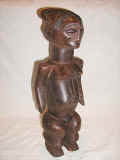 Ansestral Figure
Ansestral Figure
Material: wood
Size: 20" x 6" x 5"
|
|
MARKA
(WARKA)
Mali, Burkina Faso
The
Marka are a Mande subgroup. This ethnic group is independent from the
Bambara but their styles show a strong Bambara influence. The Marka are
famous for their masks and puppets. Similar to Bambara's
ntomo society masks, Marka masks are generally carved with
horns, comb or crest on top of the head, but unlike Bambara masks they
are often covered with metal sheeting. The Marka dress their masks in
gaily-colored costumes made of cloth; they always appear in pairs, to
represent man's courting of woman. Masks with a comb, similar to the
ntomo masks of the Bambara, are danced in the context of adolescent
boys’ initiation rites. |
|

SOLD
Male tji wara (antelope headdress)The
400,000 Marka are a Mande subgroup. This ethnic group is independent from
the Bambara but their styles show a strong Bambara influence. They live in
the region that extends from the north of the Bambara to the Senegalese
border. The
dry savanna permits no more than a subsistence economy, and the soil
produces, with some difficulty, millet, rice, and beans. Among the best
known of their associations is the
tji wara. In
the past the purpose of this association was to encourage cooperation among
all members of the community to ensure a successful crop. In recent time,
however, the concept of
tji wara
has become associated with the notion of good farmer, and the
tji wara
masqueraders are regarded as a farming beast. Always performing together in
a male and female pair, the coupling of the antelope masqueraders speaks of
fertility and agricultural abundance.
According to
one interpretation, the male antelope represents the sun and the female the
earth
Material: wood, metal sheeting, animal hair,
cotton tassels
Size: 65" x 18" x 4"
SOLD |
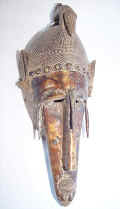
N’tomo ceremonial mask.
The 400,000 Marka live principally from agriculture with some subsidiary
cattle. The dry savanna permits no more than a subsistence economy, and the
soil produces, with some difficulty, millet, rice, and beans. Although the
Marka are independent from the Bambara their styles show a strong Bambara
influence. The Marka are mostly
famous for their masks and puppets. Their masks are often partly covered
with metal sheeting. The Marka dress the masks in gaily-colored costumes
made of cloth. The masks were used in two rituals, during the circumcision
ceremony of adolescents, and when circumcised men advanced from one grade to
another. Along the Niger River the Marka use the masks in ceremonies related
to fishing and farming. The specific function of this mask during ceremonies
is not clear.
Material: wood
Size:
19" x 7" x 7" |
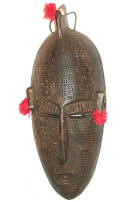
Ceremonial mask.
Marka masks are often partly covered with
metal sheeting. The Marka dress the masks in gaily-colored costumes made of
cloth. The masks were used in two rituals, during the circumcision ceremony
of adolescents, and when circumcised men advanced from one grade to another.
Along the Niger River the Marka use the masks in ceremonies related to
fishing and farming. The specific function of this mask during ceremonies is
not clear.
Material: wood, metal cotton tread
tassles. Size:12" x 5" x 3" |

N’tomo ceremonial mask.
Among the Marka who live across the Mali border in Burkina
Faso these masks, without the candelabra of horns, are worn by the N’domo
society members at the circumcision ceremony of adolescents and as men
advance from one grade to another. Various grades of membership are based on
age. The face, sheathed in metal, is long like the nose of the antelope, two
horns rise from the hairline. Narrow vertical rods of metal hang across the
eyes; they end in small tassels of red cotton threads.
Material: wood,
bronze metal, red cotton thread tassles
Size: 30" x 10" x 7" |
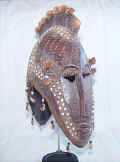
Ntomo
Janus-type
ceremonial mask.
The 400,000 Marka live principally from agriculture with some
subsidiary cattle. The Marka
are famous for their masks and puppets. Similar to Bambara's
Ntomo
society masks, Marka masks are often carved with horns, comb or crest on top
of the head. The image of antelope head is a very often used motif in the
Marka masks, as according to their mythology, it taught men how to farm. The
masks of this type were used in two rituals, during the circumcision
ceremony of adolescents, and when circumcised men advanced from one grade to
another. Along the Niger River the Marka use the masks in ceremonies related
to fishing and farming. The Marka dress their masks in gaily-colored
costumes made of cloth; they often appear in pair, to represent man’s
courting of woman. This unusual Janus-type mask may be considered rare.
cotton tassels has been used by the Marka.
Material:
wood, beads, cowries, cotton tassels
Size:
17" x 13" x 6" |
|
MASAI
(MAASAI,
MASSAI)
Kenya and
Tanzania
The 350,000 Masai living mainly in Kenya and Tanzania are
nomadic herdsmen. For them notions of wealth and prestige are intimately
linked with the size of animal herds. Among the Masai, cattle are
believed to be a gift from God. The Masai have a deep disregard for any
agricultural activity, seeing the earth as dirty. Consequently, they do
not bury their dead in the earth; they build their houses from cow dung,
not clay from the earth like many African agrarian peoples. They are
known for their courage and magnificent physiques; young Masai warriors,
armed only with a shield and spear, are required to slay a lion. The
Masai have long maintained an enmity for the Kukuyu and other Bantu
tribes of the region. For the Masai notions of wealth and prestige are
intimately linked with the size of animal herds. Cattle are believed to
be a gift from God. The Masai have a deep disregard for any agricultural
activity, seeing the earth as dirty. Consequently, they do not bury
their dead in the earth; they build their houses from cow dung, not clay
from the earth like many African agrarian peoples.
There are no specialized artists among the Masai. Individuals
produce items of adornment and utilitarian objects according to need.
There is a division of labor along gender line. Women are responsible
for beadwork, making necklaces and earrings, decorating gourds, men
create the elaborate coiffures worn by young warriors and carve their
own personal objects, including headrests, walking canes, and
leather shields decorated with polychrome decorations.
|
|

Spear. The Masai are a tall, well-built,
slender nomadic people. They keep cattle, sheep and goats, donkeys and dogs,
and the cattle cult is a feature of their culture. The system of initiation
and age grades is the basic characteristic of Masai social life and has
produced a most effective military organization. The boys enter an age-group
at circumcision and from then on count among the twelve- to
sixteen-year-old, who, with others, are bound to take part in fighting.
After the feast that closes the circumcision rites the boys are given a
spear, a shield and a sword and are sent into the bush where they practice
hunting and learn the elements of a warrior’s life. After several years of
training they become warriors responsible for protecting the large herds of
cattle from thieves and wild beasts. They also form the combat force if
there is a war.
Material: wood, metal (???)
Size: |

Spear with a removable top. Origin unknown
Materials: wood, metal
Size: 34" x 2" |
 |
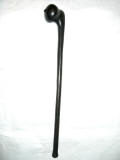 Fighter
club. The Masai are nomadic. They are a tall, well-built, slender
people. The heads of the women are shaved, as are the heads of married and
of uninitiated men. The Masai keep cattle, sheep and goats, donkeys and
dogs, and the cattle cult is a feature of their culture. The system of
initiation and age grades is the basic feature of Masai social life and has
produced a most effective military organization. The tribe is divided into
young men or boys and groups of initiated men who pass through successive
stages as warriors and elders, differentiated by duties, privileges and
details of costume. The center of political gravity is with the warrior
class and there are no chiefs. Their weapons are spears, clubs and a
peculiar sword. This perfectly made and balanced club presents a very good
example of the Masai weapon. Fighter
club. The Masai are nomadic. They are a tall, well-built, slender
people. The heads of the women are shaved, as are the heads of married and
of uninitiated men. The Masai keep cattle, sheep and goats, donkeys and
dogs, and the cattle cult is a feature of their culture. The system of
initiation and age grades is the basic feature of Masai social life and has
produced a most effective military organization. The tribe is divided into
young men or boys and groups of initiated men who pass through successive
stages as warriors and elders, differentiated by duties, privileges and
details of costume. The center of political gravity is with the warrior
class and there are no chiefs. Their weapons are spears, clubs and a
peculiar sword. This perfectly made and balanced club presents a very good
example of the Masai weapon.
Material: wood
Length: 22" x 2" x 2" |
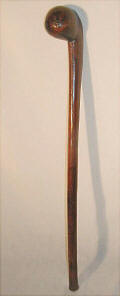 Fighter
club. The Masai are nomadic. They are a tall, well-built, slender
people. The heads of the women are shaved, as are the heads of married and
of uninitiated men. The Masai keep cattle, sheep and goats, donkeys and
dogs, and the cattle cult is a feature of their culture. The system of
initiation and age grades is the basic feature of Masai social life and has
produced a most effective military organization. The tribe is divided into
young men or boys and groups of initiated men who pass through successive
stages as warriors and elders, differentiated by duties, privileges and
details of costume. The center of political gravity is with the warrior
class and there are no chiefs. Their weapons are spears, clubs and a
peculiar sword. This perfectly made and balanced club presents a very good
example of the Masai weapon. Fighter
club. The Masai are nomadic. They are a tall, well-built, slender
people. The heads of the women are shaved, as are the heads of married and
of uninitiated men. The Masai keep cattle, sheep and goats, donkeys and
dogs, and the cattle cult is a feature of their culture. The system of
initiation and age grades is the basic feature of Masai social life and has
produced a most effective military organization. The tribe is divided into
young men or boys and groups of initiated men who pass through successive
stages as warriors and elders, differentiated by duties, privileges and
details of costume. The center of political gravity is with the warrior
class and there are no chiefs. Their weapons are spears, clubs and a
peculiar sword. This perfectly made and balanced club presents a very good
example of the Masai weapon.
Material: wood
Length: |
|
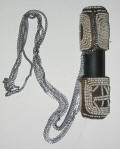 |
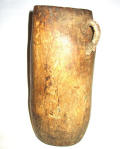 |
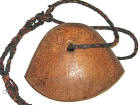
8" x 6" x 4" |
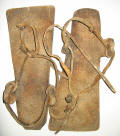 |
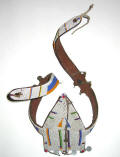 |
|
MENDE
Sierra Leone and Liberia
The 2,000,000 Mende comprise numerous kinds of social structure,
such as firmly marked kin groups, political hierarchies and societies
for diverse purposes: training boys and girls in appropriate behavior,
protection against enemies or curing illnesses. The Mende are farmers
who grow rice, yams, peanuts, and cocoa and who collect palm oil. They
practice crop rotation to avoid exhausting the soil. Most bodily ills
are believed to result from transgressions against the rules of conduct
laid down by one sodality to another. The Mende are best known for
smooth, black, helmet-shaped masks, named sowei, used by the
sande society, in particular, during
the initiating girls. The initiates learn wisdom, beauty, grace, and
self-control, all of which they will need within the multigenerational,
polygamous households of their future husbands. All Mende girls join the
sande society at puberty. Representing female water spirits, the
masks have an idealized female face whose aesthetic reflects religious
and philosophical ideals. The design of the facial features conforms to
strict conventions and has symbolic content. These masks are
characterized by the shiny skin, the rings at the neck and the elaborate
hair styling that suggest good health and a well-to-do social condition.
The characteristic rings at the base of the masks can be explained as
the concentric ripples created as the spirit emerges from the water. On
the other hand, they are also believed to represent folds of fat,
considered a sign of beauty, fertility, vitality, and health. The
coiffures, on the other hand, display a great range of variations, which
reflect changing fashions and thus may facilitate the dating and
localization of the masks. These helmets were carved from the full trunk
of a large tree. Sowei appears in public during the time when
young girls are initiated into adulthood. It may also emerge at the
crowning of or during the funeral ceremonies of a paramount chief. The
masks are carved by men, but danced by women. This is unusual in Africa,
since men usually wear masks that conceal the face. They were worn over
the head with the rim resting on the shoulders. There are helmets with
one, two, or four faces. Because the mask is "found" beside a stream
deep in the forest, where the sande
spirit is said to live, and is supposed not to be an artifact at all,
the carver in this case is anonymous. The dancer takes care that her
costume contain no opening other than a narrow slit for the eyes, not to
come into contact with the spirit, which she imagines as possessing a
fearful, all-consuming power.
Members of the corresponding male society, poro,
also wear masks, although they are of differing form. The women's
yasse, a divination and healing
society, employs slender human figures called minsere. Large ugly
gongoli masks are used entirely for entertainment. Fecundity
fetishes are also known.
For generations, farmers in Sierra Leone and adjoining portions
of Guinea and Liberia have unearthed small figures carved of soapstone
and other types of rock. The imagery and the style of these sculptures
are quite varied, especially among those found in the lands now
inhabited by the Kissi and Kono people. In lands now owned by the Mende
people, farmers place excavated stone figures or freestanding heads in
their rice fields or palm groves. Regarded as the representatives of
previous owners of the land, the objects are given offerings and asked
to bring abundant harvests. The Mende call these stone images nomoli
(plural: nomolosia) -- “found spirit.” |
|
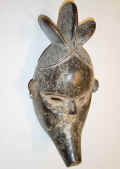
Material: wood
Size: 16" x 8" x 5" |
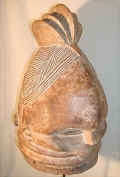
Sowei
(Bundu) helmet mask.
The 2,000,000 Mende
comprise numerous kinds of social structure, such as firmly marked kin
groups, political hierarchies and societies for diverse purposes: training
boys and girls in appropriate behavior, protection against enemies or curing
illnesses. The Mende are farmers who grow rice, yams, peanuts, and cocoa and
who collect palm oil. The Mende are best known for black, helmet-shaped
masks, named sowei or bundu used by the
sande society, in
particular, during the initiating girls. The initiates learn wisdom, beauty,
grace, and self-control, all of which they will need within the
multigenerational, polygamous households of their future husbands. All Mende
girls join the sande society at puberty. Representing female water
spirits, the masks have an idealized female face whose aesthetic reflects
religious and philosophical ideals. The design of the facial features
conforms to strict conventions and has symbolic content. The neck rings
which are a significant characteristic of all sovei masks must not be
regarded as representing obesity but as placing a plastic emphasis on the
fine lines of the neck which is highly esteemed and regarded as being
beautiful. The masks are carved by men, but danced by women. This is unusual
in Africa, since men usually wear masks that conceal the face. These masks
were worn over the head.
Material: wood
Size: 22" x 14" x 15" |
|
MITSOGHO TSOGO (APINDJI,
ASHOGO, MITSOGHO, SHOGO)
Gabon
The Tsogo are a small population of central
Gabon and live in a high valley of the Ngounie River, a mountainous and
forest covered terrain. A region criss-crossed with rivers, and cut with
many deep-sided valleys and difficulty accessible ridges, Tsogo country
is also known for its humidity and its tenacious mists in the dry
season. Counting some 13,000 to 15,000 individuals, the Tsogo live in
autonomous village communities, and practice a rudimentary
slash-and-burn agriculture which they supplement with hunting and
fishing as well.
According to oral tradition, linguistic
cross-referencing and noted cultural concordances, the Tsogo are said to
have come long ago from the eastern regions of Gabon. The Tsogo are
organized into six exogamous and matrilineal clans. Each individual is
involved within a very complex socio-religious system comprised of a
whole series of traditional initiatory societies. These societies,
separate for males and females, concern themselves with the education of
the young, as well as activities dealing with politics, social affairs,
the law, religion, medicine and artistic pursuits. Each of these
societies, more or less secret in character, controls a particular
aspect of traditional knowledge, the transmission of which was, and
remains, very confidential. The Tsogo’s seven initiatory societies
develop their activities in ongoing interrelationship. The foremost
among them is the bwete. The women participate in the rites of
boo (charged with enforcing public order and respect for customs)
and omboudi (a possession cult of divinatory nature). |
|
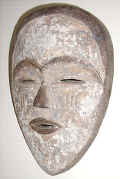
Ceremonial mask.
Counting some 13,000 to 15,000 individuals, the Tsogo live in autonomous
village communities, and practice a rudimentary slash-and-burn agriculture
which they supplement with hunting and fishing as well. The Tsogo are
organized into six exogamous and matrilineal clans. Each individual is
involved within a very complex socio-religious system comprised of a whole
series of traditional initiatory societies. These societies, separate for
males and females, concern themselves with the education of the young, as
well as activities dealing with politics, social affairs, the law, religion,
medicine and artistic pursuits. The Tsogo masks were covered in white
pigments and were carved with an open mouth, a small triangular nose, and
typical slanted eyes set under M-shaped brows. The masks are worn during
funeral ceremonies.
Material: wood
Size: 13" x 10" x 10" |
|
MONTOL
Nigeria
The
Montol people live on the right bank of the Benue River and are known
for their small figures with splayed legs and hands. Members of the
Komtin male secret society employ these ancestor representations in
divination and curative ceremonies.
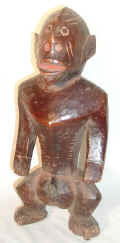
Material: wood
Siza: 13" x 7" x 3" |
|
MOSSI
(MOLE,
MOOSE, MOSI)
Burkina Faso
The first Mossi Empire was founded by invaders from northern
Ghana. Today, the Mossi are the largest tribe living in Burkina Faso.
They number 2,2 to 3,5 million and are the only ethnic group of Inland
West Africa to have a centralized governing body, in addition to clans
and professional corporations led by elders known as
zaksoba. They are an ethnically diverse people divided
into two social groups. Political power resides in nakomze, whose
ancestors invaded the region in 15th century and subjected the various
autochthonous groups living there. From these arose the tengabisi,
a heterogeneous population whose kinship groups have provided the
religious leaders of the Mossi to this day. On the north,
one encounters a region of Sahelian desert steppes, then further south a
zone of tree-field savannas, which gives way to forestland in the deep
south. The greater part of the population lives off agriculture and
cattle breeding. They grow millet, sorghum, maize, sesame,
peanuts, and indigo. Cotton, introduced by the French during the
occupation, is also cultivated over large stretches of land. Since the
beginning of the century, the family has not been regarded as part of a
community, since custom required that, immediately after circumcision,
the eldest son leave to live independently from his father. Similarly,
the young wife had no status whatsoever until the birth of her first
child, which gave her the right to visit her parents. She did not raise
her children, who were entrusted to older wives. On the other hand, at
the death of a farther, the son would receive the wives and fields of
his father.
The
blacksmiths-sculptors formed a separate caste and lived in separate
quarters; they married exclusively within the caste. They were feared by
their neighbors and participated actively in rituals. They made jewelry,
metal and wood sculpture, statues, and masks. Brass figures and wooden
ancestor figures are controlled by the Mossi ruling elite. Maintaining
good relations with the ancestors and a variety of supernatural forces
is a major concern of Mossi ritual and motivates art production in the
region. Figures are used by the ruling class to validate political
power, and masks are used by the conquered peoples to honor the spirits
of the wilderness and control the forces of nature. The aristocracy used
statues, even though it had adopted Islam in the seventeenth century.
For the most part female, linked to the power of the chiefs, these
figures commemorated ancestors and were kept inside the hut of the
oldest of the wives. They appeared only at the funeral of the sovereign
and at the time of the annual sacrifice when the first fruit of the
harvest would be offered.
Lineages and clans of the indigenous tengabisi
inhabitants own the masks, and only the large group of farmers
and the group of smiths employ a variety of masks. Mossi sculptors are
mostly famous for their polychrome masks. The farmers,
“children of the earth” and descendants of the autochthones, still use
huge masks; formerly, these masks were regarded as the seat of the
spirit, but they might also represent the totemic animal of the clan.
Each family would refer to an appropriate myth explaining the mask’s
origin: generally, it was most often a catastrophe that had brought a
sacred animal, or even a god, to make a gift of a mask to an ancestor,
the power of mask allowing the restoration of order within the clan;
then, too, at the ancestor’s death the mask would become the material
structure of his soul. These masks made their appearance several times
during the course of the year: they would escort the dead, thus helping
them to join the world beyond. They preside over the sacrifices offered
at the beginning of the rainy season, which were to insure the community
a good millet crop and harvest of wild fruits. They “supervised,” before
the first harvest, the deference given to planted seeds corresponding to
a period of famine. Between “appearances,” the masks remained on the
family shrine, where they received prayers and sacrifices for those
members of the family who were in need, and they aided communication
with the ancestors. The mask types evince regional differences.
The
blacksmiths also used to sculpt figures called biiga, often
covered in leather and decorated with cowrie shells and beads. The
function of these wooden “dolls” goes well beyond game-playing. As an
educational toy, the biiga was dressed, washed, and carried on
the back or placed on the ground under the mother’s eyes. The biiga
has a complex symbolism that, at first glance, seems contradictory: for
the little girl it is, at one and the same time, the power that will
cause her to have a child and the baby she is learning to care for. The
biiga passes from mother to daughter or from sister to sister.
Biiga
have cylindrical bases; arms and legs are missing, but the pendulous
breasts, symbol of motherhood, are accentuated.
|
|
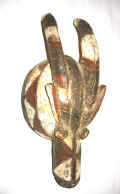
Headdress zazaigo mask . The Mossi numbering 3,000.000
is the largest tribe living in Burkina Faso.
They are sedentary Sahel farmers living in mud huts with straw roofs,
and have retained animist cult and rituals. They keep the most ancient
cultural traditions. The Mossi make both political art and spiritual art.
Figures are used by the ruling class to validate political power, and masks
are used by the conquered peoples to control the forces of nature. This mask
belongs to the group of masks characterized by a range of animal depictions
including antelopes, ducks, roosters. The zazaigo masks represent
totem animals, which confronted the group’s ancestors in the bush. These
masks are used at funerals, but also for entertainment.
Material: wood
Size: 15" x 7" x 7" |
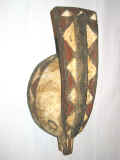
Headdress antelope zazaigo mask . The 3 million Mossi
exceed a third of the whole population of Burkina Faso. They are sedentary
farmers living in mud huts with straw roofs, and have retained animist cult
and rituals. They keep the most ancient cultural traditions. The Mossi make
both political art and spiritual art. Figures are used by the ruling class
to validate political power, and masks are used by the conquered peoples to
control the forces of nature. This mask belongs to the group of masks
characterized by a range of animal depictions including antelopes, ducks,
roosters. The zazaigo masks represent totem animals, which confronted
the group’s ancestors in the bush. These masks are used at funerals, but
also for entertainment.
Material: wood
Size: 13" x 7" x 7"
|
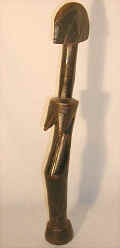 Biiga
fertility doll. The Mossi represent a third of the population of
Burkina Faso, or the “land of upright and honest people.” The
blacksmiths-sculptors formed a separate caste and lived in separate
quarters; they married exclusively within the caste. The function of the
biiga goes well beyond game-playing. As an educational toy, the
biiga was dressed, washed, and carried on the back or placed on
the ground under the mother’s eyes. The function of the biiga
becomes more serious as a girl attains womanhood. It is hoped that the
doll will encourage an early pregnancy and a vigorous baby. After a
successful birth, the doll is kept for the female child. The biiga
has a complex symbolism that, at first glance, seems contradictory; for
the little girl it is, at one and the same time, the power that will
cause her to have a child and the baby she is learning to care of.
According to J. - B. Bacquart, such dolls were given to newly
circumcised girls. Biiga
fertility doll. The Mossi represent a third of the population of
Burkina Faso, or the “land of upright and honest people.” The
blacksmiths-sculptors formed a separate caste and lived in separate
quarters; they married exclusively within the caste. The function of the
biiga goes well beyond game-playing. As an educational toy, the
biiga was dressed, washed, and carried on the back or placed on
the ground under the mother’s eyes. The function of the biiga
becomes more serious as a girl attains womanhood. It is hoped that the
doll will encourage an early pregnancy and a vigorous baby. After a
successful birth, the doll is kept for the female child. The biiga
has a complex symbolism that, at first glance, seems contradictory; for
the little girl it is, at one and the same time, the power that will
cause her to have a child and the baby she is learning to care of.
According to J. - B. Bacquart, such dolls were given to newly
circumcised girls.Material wood
Size: 19" x 4" x 2" |

Karanga mask. The Mossi are farmers and
herdsmen. They are unique in Burkina Faso for their centralized and
hierarchical political system, in addition to clans and professional
corporations led by elders. At the apex of the political system is the
Moro Naba, or Emperor of the Mossi, whose palace is in Ouagadougou. The
rulers use wooden figures to validate political power, while the commoners
use masks to honor the spirits of the wilderness. The masks embody spirit
powers, nature spirits of the sort found among many farming peoples. In some
regions masks are housed within ancestral shrines during periods when they
are not being danced, to be augmented by ancestral powers that control the
earth and productivity, all in the well-being of the people and their
natural environment. The karanga masks appear during funeral
occasions to accompany the dead to their tombs, at agricultural rites, and
other important community events. Their task is also to protect wild
plants, whose use is collectively regulated.
Material: wood
Size: |
|
|
|
|
|
|
|
|
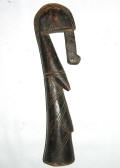
Doll. The doll is a popular subject of
carving among the Mossi of Burkina Faso. One of the doll’s functions is to
train little girls for their future roles as mothers, another function is
magic. The toys are fed, washed, and dressed in bits of cloth and carried
about on small backs just like the babies that are bundled on the backs of
their mothers. A downward extension from the forehead has been interpreted
both as an elephant’s trunk and a phallus. Another interpretation is that
this extension represents the hairdo typical of unmarried Mossi girls. The
wooden dolls are made in the blacksmiths’ compound by smiths in their spare
time.
Material: wood
Size: 12" x 3" x 2" |
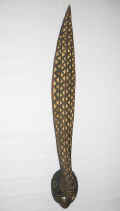 Karanga
mask. The Mossi number
about 3 million and are the largest ethnic
group living in Burkina Faso. They are farmers and herdsmen. They are unique
in Burkina Faso for their centralized and
hierarchical political system, in addition to clans and professional
corporations led by elders. At the apex of the political system is the
Moro Naba, or Emperor of the Mossi, whose palace is in Ouagadougou. The
rulers use wooden figures to validate political power, while the commoners
use masks to honor the spirits of the wilderness. The Mossi are closely
associated with totemic animals: the relationship that men and animals hold
is of reciprocal dependence and the disgrace or prosperity of one group is
reflected also on the other. The karanga masks representing spirits
appear during funeral occasions to accompany the dead to their tombs or,
placed on familial altars, they are an instrument of communication with the
dead. Their task is also to protect wild plants, whose use is collectively
regulated. Karanga
mask. The Mossi number
about 3 million and are the largest ethnic
group living in Burkina Faso. They are farmers and herdsmen. They are unique
in Burkina Faso for their centralized and
hierarchical political system, in addition to clans and professional
corporations led by elders. At the apex of the political system is the
Moro Naba, or Emperor of the Mossi, whose palace is in Ouagadougou. The
rulers use wooden figures to validate political power, while the commoners
use masks to honor the spirits of the wilderness. The Mossi are closely
associated with totemic animals: the relationship that men and animals hold
is of reciprocal dependence and the disgrace or prosperity of one group is
reflected also on the other. The karanga masks representing spirits
appear during funeral occasions to accompany the dead to their tombs or,
placed on familial altars, they are an instrument of communication with the
dead. Their task is also to protect wild plants, whose use is collectively
regulated.
Material: wood
Size: 45" x 7" x 5" |

Mossi
sculptors are mostly famous for their polychrome masks. Formerly,
these masks were regarded as the seat of the spirit, but they might also
represent the totemic animal of the clan. Each family would refer to an
appropriate myth explaining the mask’s origin: generally, it was most often
a catastrophe that had brought a sacred animal, or even a god, to make a
gift of a mask to an ancestor, the power of mask allowing the restoration of
order within the clan; then, too, at the ancestor’s death the mask would
become the material structure of his soul. These masks made their appearance
several times during the course of the year: they would escort the dead,
thus helping them to join the world beyond. They preside over the sacrifices
offered at the beginning of the rainy season, which were to insure the
community a good millet crop and harvest of wild fruits. They “supervised,”
before the first harvest, the deference given to planted seeds corresponding
to a period of famine. Between “appearances,” the masks remained on the
family shrine, where they received prayers and sacrifices for those members
of the family who were in need, and they aided communication with the
ancestors. The mask types evince regional
differences.
Material: Wood
Size: 50" x 9" x 6" |
|
MUMUYE
(MUMOYE)
Nigeria and
Cameroon
The
Mumuye mostly live in northeastern Nigeria between the cities of Jalingo
and Zinna, in a region that is bounded by the bend of the Benue River
and the Cameroon border. Estimated to number 70,000 to 400,000 they
cultivate sorghum, millet, and yams. Socially they are divided
into small family groups called dola, which
are headed by a council of elders with an elected leader. Due
to the difficulty of access to their land of rocky hills and savannas,
the Mumuye remained in near total isolation until 1959. Mumuye
artists are famous for their wooden statues known as
iagalagana. The Mumuye statuary was discovered in
1968. With no royal system, the Mumuye are organized by age classes and
choose a village chief who is assisted by a council of elders. The
vabong secret society regulates Mumuye religious life. Entry into
the society is achieved through initiation ceremonies. The initiation of
boys begins at the age of ten and takes place in a tsafi hut,
where the statues are kept. Even though the Mumuye show great respect
for the sculls of the ancestors, their statuary does not depict
ancestors, but rather incarnates tutelary spirits. Yet, statues
reinforce the status and prestige of their owner who, as he holds them
in his hands, has a dialogue with them and thus ensures his personal
protection. The functions of sculptural figures are varied. They
were used by both diviners and healers, whose professions included
diagnosis and cure of ill health and other kinds of misfortunes. The
figures were used to greet rainmaker's clients, guard the house, serve
as owner's confidant and in trials when men in dispute swear on
the statue, which they must kiss. Elders used them to reinforce
their status in society. It was not unusual for a figure simultaneously
to serve two or more functions. The size of statues varies from
20 centimeters to 1.6 meters. Mumuye figures are highly
abstracted, perhaps in part because they invoke forms of human and
supernatural authority. The statue may have added elements:
beads, belts, bracelets, chains, leather laces, ropes or braided
vegetable matter, brass wires, or cowrie shells. The statues’ principal
characteristic, unique in African art, is the openwork between the body
and the arms, which forms a scroll or a spiral around the slender,
cylindrical bust. The legs are usually angular, and ribbon-like
arms wrap around the torso with elbows clearly marked. The heads may
display a coiffure in the form of a crest. Scarification on face and
body is delineated and nasal septum may be perforated for the insertion
of a short section of a stalk of Guinea corn. A number of such
sculptures have large ears with pierced and distended earlobes for the
insertion of plugs. The Mumuye distinguish the gender of the figures on
the basis of the shape of the ears; only Mumuye women distend their
earlobes. This may be the only clue to determining the gender of a
figure.
There were animal vabo masks – buffalo, monkey, elephant,
leopard, and so on and also female masks. The masks would dance at the
time of sowing, harvesting, funerals, or other important events.
Vabo masquerades punish antisocial behavior and chase away
criminals, and individual names given to each male vabo mask
underscore their aggressive qualities. They also intervene in
initiation rites. Priests, whose duties were hereditary, kept the masks
in the sanctuary. |
|
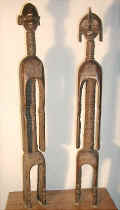
Male and female statues
incarnating the tutelary spirit. Estimated 70,000 to 400,000 Mumuye
live in northeastern Nigeria, on the left bank of the Benue River. They
cultivate sorghum, millet, and yams. Due to the difficulty of access to
their lands of rocky hills and savannas, the Mumuye remained in near total
isolation until the end of 1950th. Few were known about them
before the 1960s. Mumuye artists are famous for their unusual wooden statues
discovered only in 1968. These figures always display elongated body
features. Even though the Mumuye show great respect for the ancestors, their
statuary does not depict ancestors but rather incarnates tutelary spirits.
These statues were used by both diviners and healers, whose professions
included diagnosis and cure of ill health and other kinds of misfortune. The
figures were used to greet rainmaker’s clients, guard the house, and serve
as the owner’s confidant. They are also used in trials when men in dispute
swear on the statue, which they must kiss. Elders used them to reinforce
their status in society. It was not unusual for a figure simultaneously to
serve two or more functions.
The Mumuye distinguish the gender of the
figures on the basis of the shape of the ears; only Mumuye women distend
their earlobes. This may be the only clue to determining the gender of a
figure.
Material: wood on metal stand
Size: 33" x 3" x 4" each
figure
|
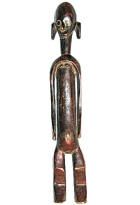
Human Figure
Material: wood Size: 25" x 6" x 4" |
|
NAMJI
(DOYAYO, DO AYO,
DOWAYO, NAMCHI, NAMSHI)
Cameroon
Namji are the people inhabiting an area in the
west of the north Cameroon. The Namji ethnic group is famous for their
wooden dolls carved with geometric features and adorned with
multi-colored bead necklaces, cowrie shells, coins, metal
strips, fiber and leather. The dolls held by young
Namji girls to play and to ensure their fertility, are considered among
the finest and the most beautiful dolls in Africa. They are carved from
solid hardwood. The
doll would have a name, be fed, be talked to and be carried strapped to
the back everywhere the child would go. The most popular place to carry
ones' doll is strapped to the back the way real infants are toted
around. This was the young girls' first baby. This was her
responsibility. This doll helped prepare the young Namji woman for her
role as mother in her future life. Though most of them
represent females, they sometimes appear as couples. |
|
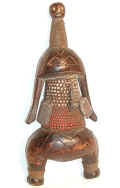
Doll.
Namji are the people inhabiting an area in the
west of the north Cameroon. They are famous for their wooden dolls carved
with geometric features and adorned with multi-colored bead necklaces,
sometimes with shells, coins, metal elements, and other materials.
Generally, the dolls held by
young Namji women to play and to ensure their fertility, are considered
among the finest and the most beautiful dolls in Africa. The
doll would have a name, be fed, be talked to and be carried strapped to the
back everywhere the child would go. These dolls help prepare the young Namji
women for their role as mothers in their future life.
Material: wood, beads,
shells
Size: |
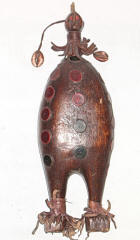 Doll.
Namji are the people inhabiting an area in the
west of the north Cameroon. They are famous for their wooden dolls carved
with geometric features and adorned with multi-colored bead necklaces,
sometimes with shells, coins, metal elements, and other materials.
Generally, the dolls held by
young Namji women to play and to ensure their fertility, are considered
among the finest and the most beautiful dolls in Africa. The
doll would have a name, be fed, be talked to and be carried strapped to the
back everywhere the child would go. These dolls help prepare the young Namji
women for their role as mothers in their future life.
Material: wood, beads,
shells
Size:
14" x 5" x 2" |
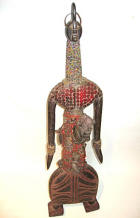
Doll.
Namji are the people inhabiting an area in the
west of the north Cameroon. They are famous for their wooden dolls carved
with geometric features and adorned with multi-colored bead necklaces,
sometimes with shells, coins, metal elements, and other materials.
Generally, the dolls held by
young Namji women to play and to ensure their fertility, are considered
among the finest and the most beautiful dolls in Africa. The
doll would have a name, be fed, be talked to and be carried strapped to the
back everywhere the child would go. These dolls help prepare the young Namji
women for their role as mothers in their future life.
Material: wood, beads,
shells
Size:
35" x 4" x 9" |
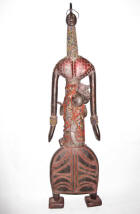 |
|
NUPE |
| |
|

|
|
|
|
NGBAKA
(BOUAKA,
BWAKA, GBAKA, MBAKA, NBAKA, NGBWAKA)
Democratic
Republic of the Congo, Central African Republic
The Ngbaka numbering 400,000 to 1,000,000
are situated mostly south of the Ubangi River, in northern part of the
Democratic Republic of the Congo. Their settlements were dispersed and
lack of overall political organization; a hamlet would generally be made
up of an extended family or patrilineal clan. They practiced
slash-and-burn agriculture growing manioc, maize, sorghum
and bananas and lived off fishing and hunting. They also raise
chickens and goats for eggs and milk. The Ngbaka
had a system of initiation named gaza or ganza: “that
which gives strength.” Future initiates had to undergo trials of
physical endurance and would attain a first level of knowledge by means
of song and corporeal techniques, particularly choreographic turns. In
the rites of passage, re-creations of ancestors played an important
role. Circumcision and excision took place after several months spent
outside the village.
Large slit drums are common, the end of which depict buffaloes
and antelopes. Artistic products include figures, masks, pipes,
necklaces, sticks, musical instruments, and zoomorphic statuettes used
in the hunt. Grooves striate the nose, forehead and the temples. The
Ngbaka men used this kind of scarification marks. Large
figures and masks feature in the Ngbaka initiation ceremonies. Ngbaka
masks, known as dagara, are worn during and after ceremonies
associated with the gaza initiation and the circumcision of young
men. They are oval and often have a concave face with an elongated
triangular nose with scarification on the nose and forehead. Ngbaka
figures are often found in pairs and can be as tall as 40”. They are
believed to represent their two primordial ancestors and are placed on
altars in houses where they fulfill a protective role. Small
anthropomorphic or zoomorphic fetishes covered in red pigment are
believed to bring good fortune.
Ngbaka dignitaries smoked anthropomorphic
pipes, often covered with copper wire, and cephalomorphic harps were
carved to accompany singers. The specific meaning and function of Ngbaka
masks appears to vary depending on the group and its particular
initiatory practice. |
|
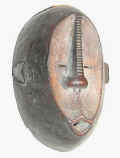
Initiation dagara mask. The
Ngbaka live in the area between the Ubangi and the Middle Lualaba Rivers in
northwest DRC. They practice primitive agriculture, hunting and fishing,
activities always preceded by a sacrifice to the ancestors.
The Ngbaka had a system of initiation
named gaza or ganza: “that which gives strength.” Future
initiates had to undergo trials of physical endurance and would attain a
first level of knowledge by means of song and corporeal techniques,
particularly choreographic turns. In the rites of passage, re-creations of
ancestors played an important role. Circumcision and excision took place
after several months spent outside the village. Ngbaka masks, known as
dagara, are worn during and after ceremonies associated with the
initiation and circumcision of young men.
Material: wood
Size: 2" x 9" x 5"
2" x 9" x 5" |
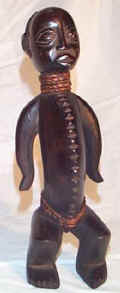 Protecting
Nabo statue. The Ngbaka, who live in the north of the DRC,
once venerated a mythological hero called Seto and his sister-spouse, Nabo.
Seto supposedly saved the first human beings from death and perpetuated the
human species. Nabo was more directly concerned with childhood diseases,
which she could heal by driving out the evel spirits causing the illness. To
obtain her help, a healer was consulted. He executed or had a sculptor
execute a statuette representing Nabo, applied a special powder to the part
of the figurine corresponding to the area of the body that was diseased,
then placed the figure at the foot of the ancestors’ altar, which also
included the representation of Seto. These two statuettes preserved the
family from a wide range of misfortunes, protected crops, brought about
successful hunt and preserved stillbirths. Protecting
Nabo statue. The Ngbaka, who live in the north of the DRC,
once venerated a mythological hero called Seto and his sister-spouse, Nabo.
Seto supposedly saved the first human beings from death and perpetuated the
human species. Nabo was more directly concerned with childhood diseases,
which she could heal by driving out the evel spirits causing the illness. To
obtain her help, a healer was consulted. He executed or had a sculptor
execute a statuette representing Nabo, applied a special powder to the part
of the figurine corresponding to the area of the body that was diseased,
then placed the figure at the foot of the ancestors’ altar, which also
included the representation of Seto. These two statuettes preserved the
family from a wide range of misfortunes, protected crops, brought about
successful hunt and preserved stillbirths.
Material: wood
Size: 11" x 3" x 4" |
|
NTOMBA
(NGATA,
LONTOMBA, NTOMBA-BOLIA)
Democratic
Republic of the Congo
The 5,000 Ntomba live on the banks of the
Lualaba River. Historically, the Ntomba had an appointed leader, but
today they live in autonomous farming communities. Ntomba artists carved
large anthropomorphic coffins, called Bondange, covered with
painted decoration. They were commissioned by important dignitaries and
contained the exhumed bones of the deceased. Later, the sarcophagus and
the bones were consigned to the river. Ngata blacksmiths cast iron
knives, which are used for executions. They produce also figures,
although their function is unknown.
|
|
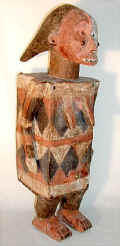
Ceremonial figure-vessel. The 5,000 Ntomba live on the banks
of the Lualaba River. They practice slash-and-burn agriculture and live off
hunting and fishing, activities always preceded by a sacrifice to the
ancestors. Historically, the Ntomba had an appointed leader, but today they
live in autonomous farming communities. Owing to their close contact with
neighboring tribes, their culture and their stylistic output overlap. The
Ntomba artists are mostly known as creators of large anthropomorphic
sarcophagi. The functions of these figure-vessels are unknown.
Material: wood
Size:25" x 8" x 8" |
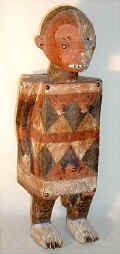
Ceremonial figure-vessel. The 5,000 Ntomba live on the banks
of the Lualaba River. They practice slash-and-burn agriculture and live off
hunting and fishing, activities always preceded by a sacrifice to the
ancestors. Historically, the Ntomba had an appointed leader, but today they
live in autonomous farming communities. Owing to their close contact with
neighboring tribes, their culture and their stylistic output overlap. The
Ntomba artists are mostly known as creators of large anthropomorphic
sarcophagi. The functions of these figure-vessels are unknown.
Material: wood
Size:25" x 8" x 8" |
|
NUNUMA
NUNA (NOUROUMA, NUNI, NURUMA)
Burkina Faso
The Nuna are one of several people called “Gurunsi”;
the others are the Winiama, the Lela, the Sisala, and others who live in
Burkina Faso and Ghana. The Nuna are estimated at 100,000 people. They
live in village communities in which a large number of dwellings are
clustered close together, with the village surrounded by farm fields.
The Nuna have no system of chiefs or other political leaders, although
the French attempted to create such centralized power during the
colonial period. Each community is instead organized by a council of the
eldest representatives of each family who meet when need arises to make
decisions on behalf of the community. The Nuna believe in a creator god
named Yi. The Nuna communities are formed around the worship of natural
spirits, which in turn establish religious laws that control the moral
and ethical conduct of life in the communities. The masks represent the
spirits of the wilderness. The Nuna make masks in the shape of poles
colored red, black, and white, or in the form of animals who often
differ only in the shape of their horns and ears: buffalo, crocodiles,
antelopes, warthogs, hyenas, and serpents. The eyes protrude, surrounded
by concentric circles, with a rather short snout on the animal masks,
and a large and protuberant mouth on the more abstract masks. Decorated
with geometric motifs, the masks are repainted every year; they are
found throughout the region. The wearer of the mask may be invisible
underneath the fiber skirt and must behave as the animal does, imitating
its gait. When rituals are properly executed, the community
receives fertility and prosperity. The property of an individual, a mask
will, upon the owner’s death, be given to his son or kept in the hut of
the ancestors of the lineage. The mask’s role is important during
ceremonies at the end of initiation, at the funeral of notables, and as
entertainment on certain market days.
There are also large figures used by diviners
to represent a spirit from the wilderness with which the diviner could
communicate and whose supernatural power he could control for the
benefit of his clients. These figures are kept together with
non-figurative objects, including jars, bottles and stones in dark
corners of the diviner’s home where they become covered with a thick
crust of offering material, especially millet porridge, beer and chicken
blood. The figures serve the same function as the spectacular masks from
the same people; they make the invisible nature spirits concrete and
permit the congregation to offer their prayers and offerings. |
|
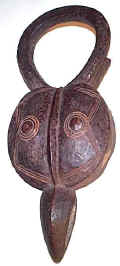
Antelope Mask.
The Nuna are one of several people called “Gurunsi”. The Nuna, estimated at
100,000 people, believe in a creator god named Yi. The Nuna communities are
formed around the worship of natural spirits.
Nuna are primarily sedentary farmers, growing millet, sorghum, and yams.
Maize, rice, peanuts, and beans are grown in addition to these staples.
Farmers throughout the region practice slash and burn farming.
The Nuna masks represent the spirits of the
wilderness. The Nuna make masks in the shape of poles colored red, black,
and white, or in the form of animals: buffalo, crocodiles, antelopes,
warthogs, hyenas, and serpents. The eyes protrude, surrounded by concentric
circles. Decorated with geometric motifs, the masks are repainted every
year. The wearer of the mask may be invisible underneath the fiber skirt and
must behave as the animal does, imitating its gait. When rituals are
properly executed, the community receives fertility and prosperity. The
mask’s role is important during ceremonies at the end of initiation, at the
funeral of notables, and as entertainment on certain market days.
Material: wood
Size:
22" x 9" x 3"
|
|
NYAMWEZI
(BANYAMWEZI, NYAMEZI, NYAMWESI,
WANJAMWEZI, WANYAMWEZI)
Tanzania
The 500,000 Nyamwezi people, whose name means either "Men of the
West" or "Men of the Moon", are the largest ethnic agrarian group in
north-central Tanzania. Socially, they are organized into villages,
which correspond to small chiefdoms, and each chief is responsible for
the material wealth of the village, while the spiritual welfare is
governed by the village sorcerer. Ancestors and chiefs have been of
considerable importance in the belief system and socio-political
structure of the Nyamwezi, and consequently most of their art relates to
these themes: theirs is one of the richest art traditions in Tanzania.
The Nyamwezi produced chief’s thrones with a human figure carved in
relief on the high back. Nyamwezi carvers are also famous for their
figures that are usually carved out of a dark, heavy wood with a shiny
surface. They tend to have strongly elongated features, and the eyes
inset with circular colored bids. Such elongated figures with distorted
limbs were used in water divination ceremonies. Since the 1950s the slim
figures were displayed by Nyamwezi dance troupes to enhance the visual
impact of their performances. |
|

Dance Puppet. The people known as
Nyamwezi are a large, loosely connected agrarian group. It was on the coast
that they were given the name ‘Nyamwezi’, meaning ‘people of the west’
(sometimes translated as ‘people of the moon’). Because of the extensive
size and ethnic diversity of Nyamwezi the art from this area shows
considerable variation in style. Ancestors and chiefs have been of
considerable importance in the belief system and socio-political structure
of the Nyamwezi, and consequently most of their art relates to these themes:
theirs is one of the richest traditions in Tanzania. This figure is a dance
puppet used in performances during various festivals.
Material: wood, beads, leather,
bark
Size: 31" x 5" x 3" |
 Ceremonial
figure. The 500,000 Nyamwezi people, whose name means ‘Men of
the West’ or ‘Men of the Moon’, are the largest ethnic group in central
Tanzania. Socially, they are organized into villages, which correspond
to small chiefdoms and each chief is responsible for the material wealth
of the village, while the spiritual welfare is governed by the village
sorcerer. The cult of ancestors, which protects each family, and also
the chiefs have been of considerable importance in the belief system and
socio-political structure of the Nyamwezi, and consequently most of
their art relates to these themes.
Nyamwezi carvers are famous for their figures, which are usually carved
out from a heavy wood with a shiny surface. They tend to have elongated
features with the eyes inset with circular white beads. Such elongated
figures with distorted limbs were used in water divination ceremonies.
These slender elegant male and
female figures are appreciated not only by collectors but also by
interior designers. These features are reminiscent of the Swiss artist
Alberto Giacometti. Ceremonial
figure. The 500,000 Nyamwezi people, whose name means ‘Men of
the West’ or ‘Men of the Moon’, are the largest ethnic group in central
Tanzania. Socially, they are organized into villages, which correspond
to small chiefdoms and each chief is responsible for the material wealth
of the village, while the spiritual welfare is governed by the village
sorcerer. The cult of ancestors, which protects each family, and also
the chiefs have been of considerable importance in the belief system and
socio-political structure of the Nyamwezi, and consequently most of
their art relates to these themes.
Nyamwezi carvers are famous for their figures, which are usually carved
out from a heavy wood with a shiny surface. They tend to have elongated
features with the eyes inset with circular white beads. Such elongated
figures with distorted limbs were used in water divination ceremonies.
These slender elegant male and
female figures are appreciated not only by collectors but also by
interior designers. These features are reminiscent of the Swiss artist
Alberto Giacometti.
Material: wood
Size: 56" x 3" x 1" |

Ceremonial figure.
The 500,000 Nyamwezi people, whose name means ‘Men of the West’ or ‘Men
of the Moon’, are the largest ethnic group in central Tanzania.
Socially, they are organized into villages, which correspond to small
chiefdoms and each chief is responsible for the material wealth of the
village, while the spiritual welfare is governed by the village
sorcerer. The cult of ancestors, which protects each family, and also
the chiefs have been of considerable importance in the belief system and
socio-political structure of the Nyamwezi, and consequently most of
their art relates to these themes.
Nyamwezi carvers are famous for their figures, which are usually carved
out from a heavy wood with a shiny surface. They tend to have elongated
features with the eyes inset with circular white beads. Such elongated
figures with distorted limbs were used in water divination ceremonies.
These slender elegant male and
female figures are appreciated not only by collectors but also by
interior designers. These features are reminiscent of the Swiss artist
Alberto Giacometti.
Material: wood
Size: 59" x 3" x 1" |

Ceremonial figure.
The 500,000 Nyamwezi people, whose name means ‘Men of the West’ or ‘Men
of the Moon’, are the largest ethnic group in central Tanzania.
Socially, they are organized into villages, which correspond to small
chiefdoms and each chief is responsible for the material wealth of the
village, while the spiritual welfare is governed by the village
sorcerer. The cult of ancestors, which protects each family, and also
the chiefs have been of considerable importance in the belief system and
socio-political structure of the Nyamwezi, and consequently most of
their art relates to these themes.
Nyamwezi carvers are famous for their figures, which are usually carved
out from a heavy wood with a shiny surface. They tend to have elongated
features with the eyes inset with circular white beads. Such elongated
figures with distorted limbs were used in water divination ceremonies.
These slender elegant male and
female figures are appreciated not only by collectors but also by
interior designers. These features are reminiscent of the Swiss artist
Alberto Giacometti.
Material: wood
Size: 59" x 3" x 1" |

Ceremonial figure.
The 500,000 Nyamwezi people, whose name means ‘Men of the West’ or ‘Men
of the Moon’, are the largest ethnic group in central Tanzania.
Socially, they are organized into villages, which correspond to small
chiefdoms and each chief is responsible for the material wealth of the
village, while the spiritual welfare is governed by the village
sorcerer. The cult of ancestors, which protects each family, and also
the chiefs have been of considerable importance in the belief system and
socio-political structure of the Nyamwezi, and consequently most of
their art relates to these themes.
Nyamwezi carvers are famous for their figures, which are usually carved
out from a heavy wood with a shiny surface. They tend to have elongated
features with the eyes inset with circular white beads. Such elongated
figures with distorted limbs were used in water divination ceremonies.
These slender elegant male and
female figures are appreciated not only by collectors but also by
interior designers. These features are reminiscent of the Swiss artist
Alberto Giacometti.
Material: wood
Size: 60" x 3" x 1" |
|
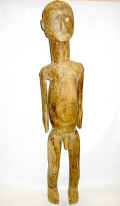 Nyamwezi (Banayamwezi, Nayamwesi, Wanjamwezi, Wanyamwezi), TanzaniaDance Puppet. The people known as Nyamwezi are a large,
loosely connected agrarian group. It was on the coast that they were
given the name ‘Nyamwezi’, meaning ‘people of the west’ (sometimes
translated as ‘people of the moon’). Because of the extensive size and
ethnic diversity of Nyamwezi the art from this area shows considerable
variation in style. Ancestors and chiefs have been of considerable
importance in the belief system and socio-political structure of the
Nyamwezi, and consequently most of their art relates to these themes:
theirs is one of the richest traditions in Tanzania. This figure is a
dance puppet used in performances during various festivals.
Nyamwezi (Banayamwezi, Nayamwesi, Wanjamwezi, Wanyamwezi), TanzaniaDance Puppet. The people known as Nyamwezi are a large,
loosely connected agrarian group. It was on the coast that they were
given the name ‘Nyamwezi’, meaning ‘people of the west’ (sometimes
translated as ‘people of the moon’). Because of the extensive size and
ethnic diversity of Nyamwezi the art from this area shows considerable
variation in style. Ancestors and chiefs have been of considerable
importance in the belief system and socio-political structure of the
Nyamwezi, and consequently most of their art relates to these themes:
theirs is one of the richest traditions in Tanzania. This figure is a
dance puppet used in performances during various festivals.
Material: wood
Size: 39" x 8" x 5" |
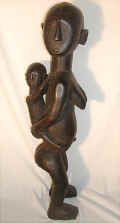 Nyamwezi
(Banayamwezi, Nayamwesi, Wanjamwezi, Wanyamwezi), Tanzania Nyamwezi
(Banayamwezi, Nayamwesi, Wanjamwezi, Wanyamwezi), Tanzania
Maternity figure. The people known as
Nyamwezi are a large, a loosely connected agrarian group with shared
cultural traits but diverse origins who live in north-central Tanzania.
Their name means ‘Men of the West’ or ‘Men of the Moon’; numbering 500,000
they are one the largest ethnic groups in Tanzania. Socially, they are
organized into villages, which correspond to small semi-autonomous chiefdoms
and each chief is responsible for the material wealth of the village. The
cult of ancestors, which protects each family, and also the chiefs have been
of considerable importance in the belief system and socio-political
structure of the Nyamwezi, and consequently most of their art relates to
these themes. Like virtually all freestanding female sculptures of the
Nyamwezi, with or without a child, this piece represents an ancestor.
Material: wood
Size: 27" x 7" x 8" |
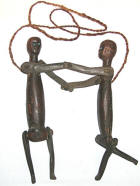 Nyamwezi (Banayamwezi, Nayamwesi, Wanjamwezi, Wanyamwezi),
TanzaniaDance Puppet. The people known as Nyamwezi are a large,
loosely connected agrarian group. It was on the coast that they were
given the name ‘Nyamwezi’, meaning ‘people of the west’ (sometimes
translated as ‘people of the moon’). Because of the extensive size and
ethnic diversity of Nyamwezi the art from this area shows considerable
variation in style. Ancestors and chiefs have been of considerable
importance in the belief system and socio-political structure of the
Nyamwezi, and consequently most of their art relates to these themes:
theirs is one of the richest traditions in Tanzania. These figures are a
pair of
dance puppets used in performances during various festivals.
Nyamwezi (Banayamwezi, Nayamwesi, Wanjamwezi, Wanyamwezi),
TanzaniaDance Puppet. The people known as Nyamwezi are a large,
loosely connected agrarian group. It was on the coast that they were
given the name ‘Nyamwezi’, meaning ‘people of the west’ (sometimes
translated as ‘people of the moon’). Because of the extensive size and
ethnic diversity of Nyamwezi the art from this area shows considerable
variation in style. Ancestors and chiefs have been of considerable
importance in the belief system and socio-political structure of the
Nyamwezi, and consequently most of their art relates to these themes:
theirs is one of the richest traditions in Tanzania. These figures are a
pair of
dance puppets used in performances during various festivals.
Material: wood
Size: |
|
|
OGONI |
| |
23" x 9" x 9" |
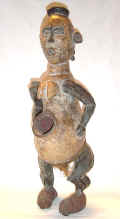
|
|
|
|
PENDE
(BAPENDE, PHENDE, PINDI, PINJI)
Democratic Republic of the Congo
The 250,000 to 500,000 Pende people settled in the region near
the Loango and Kasai Rivers. They are governed by a central authority,
but pay allegiance to family chiefs, known as Djigo.
The tribe members are divided into numerous territorial groups, the two
most important being in Kwilu and Kasai.
The
Pende political system is mainly controlled by lineage and marriage.
There is no recognized central political power, and the chiefs that do
exist do not exercise significant authority. The extended family seems
to serve the needs of social control within individual communities. The
Pende are a matrilineal people, and the eldest maternal uncle in a
family is usually recognized as heading the lineage, a position that
entails ensuring the well-being of the family and taking care of the
ancestors.
The
Pende are mainly farmers who produce millet, maize, plantain, and
peanuts. The women do the majority of the farm work and are wholly
responsible for selling goods in the community markets. The men help
with the clearing of the fields and also contribute to the diet with
occasional hunting and fishing in the numerous local rivers.
The
ancestors (mvumbi) are placated through various rituals and
offerings. The family head is responsible for taking care of the shrines
and appeasing the spirits. The Pende recognize that spirits may be
either good or bad, depending on the manner in which they died. Also,
when ancestors are neglected they will cause bad things to happen to the
family. The result may be sickness or hardship, both of which require a
visit to the local diviner to determine the best way to appease the
spirits.
Blacksmiths enjoyed enormous prestige, vestiges of which are
still alive today. Blacksmiths and chiefs are considered of equivalent
social status. When one or the other visits a village, his arrival must
be honored by a day of rest for the entire population. Even though the
society is matrilinear, the sculptor’s profession is transmitted from
father to son. The ancestors are honored most especially during the
masked celebration held in sanctuaries in the chiefs’ huts or on the
edge of the forest. A statue of the chief’s wife sometimes stands atop
the roof; it symbolizes fertility and emphasizes the importance of
women.
Pende masks are among the most dramatic works of all African
art. All told, about twenty characters and seven “masks of power”
appear in ceremonies such as millet-planting celebration or circumcision
and initiation ritual, and the ritual of enthronement of a chief. There
are two styles: the western one of the Kwilu with its mbuya mask
characterized by a somber, gloomy expression, and the Kasai style that
is more geometric and colorful. The Kwilu Pende are especially well
known for their masks that were originally used for circumcision
ceremonies but later became accessories for a type of popular theater.
Neck pendants carved by the Kwilu Pende as tiny replicas of masks must
be placed among the most exquisite examples of African micro-sculpture.
Generally made of ivory, but sometimes of wood, bone, metal, these
pendants serve as protective amulets. Kasai masks are decorated with red
and black triangles on a sienna background. The minganji, or
masks of power, represent the ancestors; the mbuya, or village
masks, represent human types, such as the chief, the diviner, the
epileptic with a twisted mouth, the madman or man in a trance, the
widow, the lover, or the executioner.
Among the major works of eastern (Kasai)
Pende are fairly large sculptures intended either to glorify the chief's
house or to serve as protective doorposts. The Pende also make ritual or
practical objects, such as chairs, stools, commanders' stuffs, flutes,
horns, whistles, drums, weapon, adzes, cups, mortars, and divination
instruments. |
|
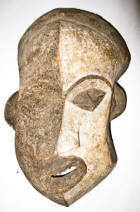 Mbuya
Mask. The mbuya, or village masks,
represent human types, such as the chief, the diviner, the madman or man in
a trance, the widow, the lover, or the executioner. All told, about twenty
characters and seven “masks of power” appear in ceremonies such as
millet-planting celebration or circumcision and initiation ritual, and the
ritual of enthronement of a chief. Mbuya
Mask. The mbuya, or village masks,
represent human types, such as the chief, the diviner, the madman or man in
a trance, the widow, the lover, or the executioner. All told, about twenty
characters and seven “masks of power” appear in ceremonies such as
millet-planting celebration or circumcision and initiation ritual, and the
ritual of enthronement of a chief.
Although they represent roles in the secular society rather than spirits,
they are used also to control supernatural forces. Worn by the celebrants at
coming out parties of newly initiated young men who have just been
circumcised, these masks represent revered mythological beings and ancestors
such as chiefs and their wives, hunters, prophets and sages.
Material: wood
Size: 12" x 7" x 5" |
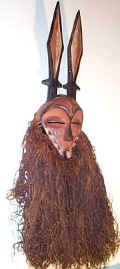 Circumcision
Mask. The Pende people form about sixty little
territorial groups,
the two most important being Kwilu and Kasai.
Every group comprises several
clans and each is headed by a chief whose main function is religious. He is
a mediator with the ancestors who are the sources of health, fecundity and
fertility of the people. The Pende are mainly farmers who produce millet,
maize, plantain, and peanuts. The women do the majority of the farm work and
are wholly responsible for selling goods in the community markets. The men
help with the clearing of the fields and also contribute to the diet with
occasional hunting and fishing in the numerous local rivers. The sculptor’s
profession is transmitted from father to son. The presented mask is the most
common type of circumcision mask: triangular human head surmounted by two
appendages of knife-like type. The whole mask is pigmented red with white
and black stripes that emphasize the carved planes of the mask. Circumcision
Mask. The Pende people form about sixty little
territorial groups,
the two most important being Kwilu and Kasai.
Every group comprises several
clans and each is headed by a chief whose main function is religious. He is
a mediator with the ancestors who are the sources of health, fecundity and
fertility of the people. The Pende are mainly farmers who produce millet,
maize, plantain, and peanuts. The women do the majority of the farm work and
are wholly responsible for selling goods in the community markets. The men
help with the clearing of the fields and also contribute to the diet with
occasional hunting and fishing in the numerous local rivers. The sculptor’s
profession is transmitted from father to son. The presented mask is the most
common type of circumcision mask: triangular human head surmounted by two
appendages of knife-like type. The whole mask is pigmented red with white
and black stripes that emphasize the carved planes of the mask.
Material: wood, fiber
Size: 19" x 8" x 3" + raffia |
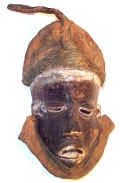 Mbuya Mask.
The 500,000 Pende people
are mainly farmers who produce millet, maize, plantain, and peanuts. The
women do the majority of the farm work and are wholly responsible for
selling goods in the community markets. The men help with the clearing of
the fields and also contribute to the diet with occasional hunting and
fishing in the numerous local rivers. The sculptor’s profession is
transmitted from father to son. In dances of the Western Pende, a group of
masks called mbuya are characterized by delicate features and fiber
headdresses. Mbuya, or sculptured wooden masks in the form of human
or animal faces, were worn with prescribed costumes by graduates of the
Mukanda initiation school in their coming-out rites. These masks represented
a great variety of village characters, including a clown, or “chief of the
dance floor,” and those whose behavior was admired or disapproved. Although
the performance was entertaining, it taught moral lessons and reinforced
Pende religious and political principals.
Mbuya Mask.
The 500,000 Pende people
are mainly farmers who produce millet, maize, plantain, and peanuts. The
women do the majority of the farm work and are wholly responsible for
selling goods in the community markets. The men help with the clearing of
the fields and also contribute to the diet with occasional hunting and
fishing in the numerous local rivers. The sculptor’s profession is
transmitted from father to son. In dances of the Western Pende, a group of
masks called mbuya are characterized by delicate features and fiber
headdresses. Mbuya, or sculptured wooden masks in the form of human
or animal faces, were worn with prescribed costumes by graduates of the
Mukanda initiation school in their coming-out rites. These masks represented
a great variety of village characters, including a clown, or “chief of the
dance floor,” and those whose behavior was admired or disapproved. Although
the performance was entertaining, it taught moral lessons and reinforced
Pende religious and political principals.
Material: wood, fiber, tissue
Size: 14" x 8" x 5" |
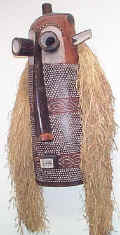
Pumbu Mask.
The 500,000 Pende people
form about sixty little kingdoms, each comprising several clans and each
headed by a chief whose main function is religious. He is a mediator with
the ancestors who are the sources of health, fecundity and fertility of the
people. The Pende are mostly farmers. The sculptor’s profession is
transmitted from father to son. This mask named pumbu a mfunu is
attributed to the Kasai (eastern) subgroup of the Pende people. The
mask is considered the most fearful and dangerous. It is used by only a few
of the most powerful chiefs. The mask is formed as a halved cylinder. Two
very large eyes project as tubes from the upper part of the face. The
pumbu serves as a symbol of the power of the chief. Unlike most masks,
it dances rarely – only in the event of special occasions determined by
divination, such as a chief’s serious illness, or a regional epidemic or
famine, indicating that ancestors may be unhappy. The pumbu
represents the executive branch of the chief’s office, which must sometimes
deal with war and execution.
Material: wood
Size: 45" x 20" x 10"(with rafia)
|

Drum or a Slit Gong in a form of a buffalo.
A slit gong is wooden drum without a drumhead. Chiefs in areas of north
central Congo took pride in ownership of such gongs. They are played with a
long wooden stick
Material: Wood
29" x 11" x 11" |
|

Panya ngombe mask. This
mask, known as panya ngombe represents a buffalo, symbol of authority
and dignity. Characteristic of this type are a horizontally oriented form,
protruding ears, and an ornament consisting of a motif of relief triangles.
These masks formerly belonged to the insignia of important chiefs (mbuya
jia ufumu). Clad in a royal garment and holding a machete, the masked
dancers appeared only during the mukanda initiation of adolescent
boys after their circumcision, to gather donations to cover the cost of the
celebration that took place after the initiation period. After circumcision
in the context of initiation was abandoned back in 1930s, similar masks are
today still incorporated in the lintel of the door to the royal treasure
house where royal masks and other regalia are kept.
Material: wood
Size: 14" x 17" x 3" |

Panya ngombe mask. This
mask, known as panya ngombe represents a buffalo, symbol of authority
and dignity. Characteristic of this type are a horizontally oriented form,
protruding ears, and an ornament consisting of a motif of relief triangles.
These masks formerly belonged to the insignia of important chiefs (mbuya
jia ufumu). Clad in a royal garment and holding a machete, the masked
dancers appeared only during the mukanda initiation of adolescent
boys after their circumcision, to gather donations to cover the cost of the
celebration that took place after the initiation period. After circumcision
in the context of initiation was abandoned back in 1930s, similar masks are
today still incorporated in the lintel of the door to the royal treasure
house where royal masks and other regalia are kept.
Material: wood
Size: 9" x 15" x 2" |

Panya ngombe mask. This
mask, known as panya ngombe represents a buffalo, symbol of authority
and dignity. Characteristic of this type are a horizontally oriented form,
protruding ears, and an ornament consisting of a motif of relief triangles.
These masks formerly belonged to the insignia of important chiefs (mbuya
jia ufumu). Clad in a royal garment and holding a machete, the masked
dancers appeared only during the mukanda initiation of adolescent
boys after their circumcision, to gather donations to cover the cost of the
celebration that took place after the initiation period. After circumcision
in the context of initiation was abandoned back in 1930s, similar masks are
today still incorporated in the lintel of the door to the royal treasure
house where royal masks and other regalia are kept.
Reserved by Client (NV)
Material: wood
Size: 30" x 9" x 5" |
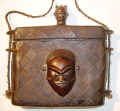
Material: wicker, wood
Size: 14" x 14" x 3" |
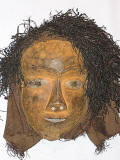
Mbuya Mask - Mbuya, or sculptured wooden masks in the
form of human or animal faces, were worn with prescribed costumes by
graduates of the Mukanda initiation school in their coming-out rites. These
masks represented a great variety of village characters, including a clown,
or “chief of the dance floor,” and those whose behavior was admired or
disapproved. Although the performance was entertaining, it taught moral
lessons and reinforced Pende religious and political principals.
This mask has unusually "naturalistic" eyes,
reflecting artists' individual approach.
Material: wood, fiber, tissue
Size: 7" x 9" x 5" + raffia
|
|
PUNU
Gabon
The Punu reside on the
left bank of the Upper Ngoume River (Gabon) and belong to the group of
tribes known as Shira which were originally part of the Luango kingdom
of Angola. With the Eshira, the Lumbo, the Vili, the Galoa, and the
Vungu people, the Punu migrated northwards during the 18th century and
settled in the area where they continue to inhabit to this day. They
live in independent villages divided into clans and families, and social
cohesion is ensured by a society known as moukouji.
Its primary role is to regulate community life with regards to social
and judicial matters, and mainly it applies itself to the neutralization
of evil forces. To this end, officiates of moukoudji utilize a
cult kit that includes statuettes, human relics and masks.
Punu masks
represent idealized female ancestors' faces. The white color of the mask
is genderless; white is a symbol for peace, deities, spirits of the
dead, and the afterlife. It is thus the predominating color in funeral
celebrations and memorials. Therefore the masks were worn during
funerals. They appeared also in the magical rites whose function was to
unmask sorcerers. The masks have realistic, mostly white but sometimes
black faces with protruding pursed lips, globular protruding eyes
incised with a curve, high-domed foreheads, and characteristic rigid
high coiffures reflecting the Punu women's hair styles. The masks often
have an Oriental expression, but no such influence has been established.
Many Punu masks can be recognized by raised diamond-shape scarification
marks on the foreheads and temples. The scarification marks on the
temples are thought to be associated either with a female ancestor, or
with a southern sub-group of the Punu tribe. Black face-masks have
exactly the same stylistic characteristics as the white masks, but they
are believed to have a judiciary function and help identify sorcerers.
The performances of the masks are nowadays intended primarily to
entertain audiences on festive occasions. Only rarely do the
masqueraders fulfill a ritual function of officiating at funerals, when
they dance as embodiments of the ancestor spirits. In performances the
dancers, wearing costumes of raffia or cotton fabric and animal pelts,
move with amazing acrobatic agility on stilts up to six and a half feet
in height.
The Punu also carve standing reliquary figures,
which watch over the bones of the deceased. Punu artists
carved also amulets and everyday objects showing faces similar to those
found on masks. It is thought they were used as prestige objects, during
magical ceremonies, or were kept alongside the ancestral bones in a
reliquary box.
|
|
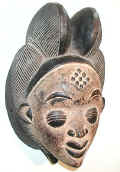
Okuyi ceremonial mask.
Punu masks
represent idealized female ancestors' faces. The masks have realistic faces,
and the hairstyle resembles the hair arrangement of the women of the region.
The coiffure and the diamond shaped marks on the forehead and the
scarifications on the temples indicate that the spirits are still members of
their ethnic group even after death. The white color of the mask is a symbol
for peace, deities, spirits of the dead, and the afterlife.
The
performances of these masks are nowadays intended primarily to entertain
audiences on festive occasions. Only rarely do the masqueraders fulfill a
ritual function of officiating at funerals, when they dance as embodiments
of the spirits of ancestors. The dancers, wearing costumes of raffia or
cotton fabric and animal pelts, move with amazing agility. The realistic
effect is rapidly dispelled when the mask is worn by the stilt dancer lifted
in the air to a height of fifteen feet. The eerie drama is intensified
because the maskers often dance at the time of full moon.
Material: wood
Size: 14" x 9" x 5" |
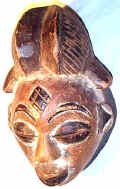
Okuyi ceremonial mask.
Punu masks
represent idealized female ancestors' faces. The masks have realistic faces,
and the hairstyle resembles the hair arrangement of the women of the region.
The coiffure and the diamond shaped marks on the forehead and the
scarifications on the temples indicate that the spirits are still members of
their ethnic group even after death. The white color of the mask is a symbol
for peace, deities, spirits of the dead, and the afterlife.
The
performances of these masks are nowadays intended primarily to entertain
audiences on festive occasions. Only rarely do the masqueraders fulfill a
ritual function of officiating at funerals, when they dance as embodiments
of the spirits of ancestors. The dancers, wearing costumes of raffia or
cotton fabric and animal pelts, move with amazing agility. The realistic
effect is rapidly dispelled when the mask is worn by the stilt dancer lifted
in the air to a height of fifteen feet. The eerie drama is intensified
because the maskers often dance at the
time of full moon.
Material: wood
Size: 11" x 8" x 4" |
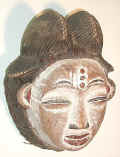
Okuyi ceremonial mask.
Punu masks
represent idealized female ancestors' faces. The masks have realistic faces,
and the hairstyle resembles the hair arrangement of the women of the region.
The coiffure and the diamond shaped marks on the forehead and the
scarifications on the temples indicate that the spirits are still members of
their ethnic group even after death. The white color of the mask is a symbol
for peace, deities, spirits of the dead, and the afterlife.
The
performances of these masks are nowadays intended primarily to entertain
audiences on festive occasions. Only rarely do the masqueraders fulfill a
ritual function of officiating at funerals, when they dance as embodiments
of the spirits of ancestors. The dancers, wearing costumes of raffia or
cotton fabric and animal pelts, move with amazing agility. The realistic
effect is rapidly dispelled when the mask is worn by the stilt dancer lifted
in the air to a height of fifteen feet. The eerie drama is intensified
because the maskers often dance at the time of full moon.
Material: wood
Size: 12" x 9" x 7" |
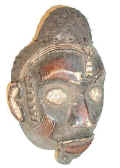
Okuyi ceremonial mask.
Punu masks
represent idealized female ancestors' faces. The masks have realistic faces,
and the hairstyle resembles the hair arrangement of the women of the region.
The coiffure and the diamond shaped marks on the forehead and the
scarifications on the temples indicate that the spirits are still members of
their ethnic group even after death. The white color of the mask is a symbol
for peace, deities, spirits of the dead, and the afterlife.
The
performances of these masks are nowadays intended primarily to entertain
audiences on festive occasions. Only rarely do the masqueraders fulfill a
ritual function of officiating at funerals, when they dance as embodiments
of the spirits of ancestors. The dancers, wearing costumes of raffia or
cotton fabric and animal pelts, move with amazing agility. The realistic
effect is rapidly dispelled when the mask is worn by the stilt dancer lifted
in the air to a height of fifteen feet. The eerie drama is intensified
because the maskers often dance at the time of full moon.
Material: wood
Size: 10" x 7" x 5" |
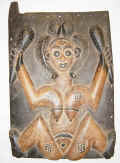
Door.
The 40,000 Punu reside on
the left bank of the Upper Ngoume River (Gabon) and belong to the group of
tribes known as Shira. They live in independent villages divided into clans
and families, and social cohesion is ensured by a society known as
moukouji.
Its primary role is to regulate community life with regards to social and
judicial matters, and mainly it applies itself to the neutralization of evil
forces. This example of the ‘displayed
female motif’ is decorated with an elaborate coiffure and body
scarification. Costumed stilt dancers wore Punu masks with a similar face.
This image represents the spirit of beautiful young woman who returned from
dead to participate in village life. The whitened figure (white color has
been apparently mostly erased) makes reference not only to the dead, but
also to anti-witchcraft techniques. Witches were believed to be most active
and powerful at night, and whiteness refers to light and clarity, which
stand in opposition to night and mystery. In Gabon and much of central
Africa clairvoyants ring their eyes with white clay (kaolin) as a strategy
for detecting witchcraft.
Material: wood
Size: 15" x 22" x 2" |
|
Total
this Section |
129 |